2019-01-31 - Nº 196
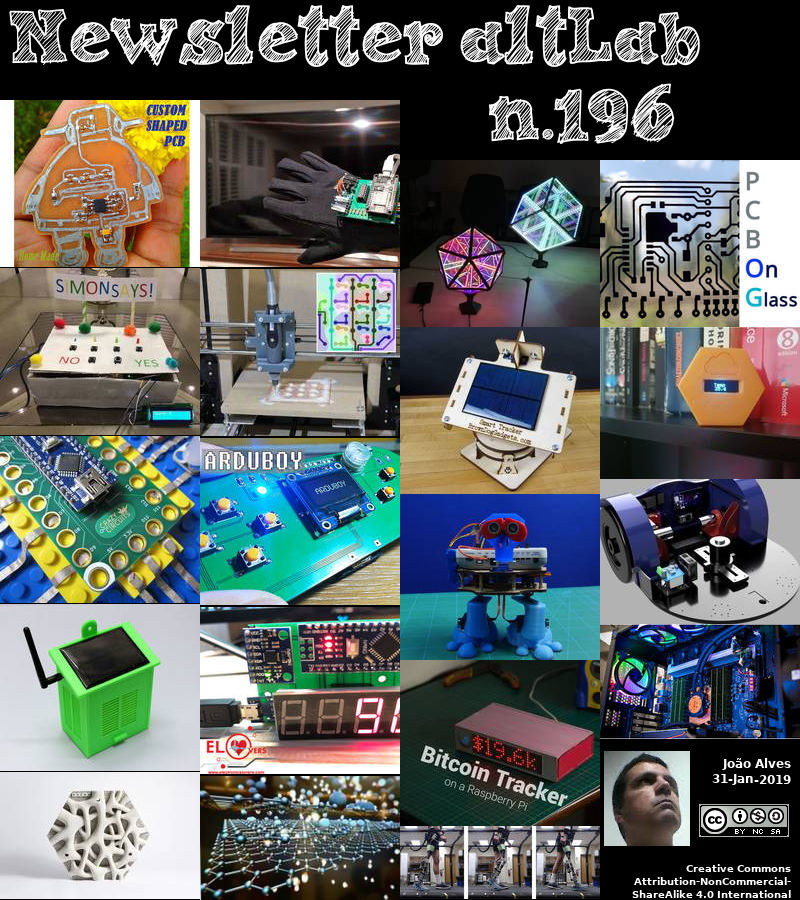
Editorial
Esta é a Newsletter Nº 196 que se apresenta com o mesmo formato que as anteriores. Se gostar da Newsletter partilhe-a!
Todas as Newsletters encontram-se indexadas no link.
Esta Newsletter tem os seguintes tópicos:
Faz anos hoje que nascia, em 1769 - André-Jacques Garnerin. Este Aeronauta francês foi o primeiro a usar um pára-quedas regularmente e com sucesso. Ele aperfeiçoou o pára-quedas e deu saltos de maiores altitudes do que era possível antes. Em 22 de Outubro de 1797, aos 28 anos, Garnerin fez o seu primeiro salto sobre o Parc Monceau, em Paris. Ele caiu de um balão de ar quente a 3000 pés. O seu pára-quedas, com 36 arcos e linhas, era semi-rígido, lembrando um pouco um guarda-chuva. A descida foi um sucesso, excepto que ele balançou para frente e para trás violentamente enquanto caía. O físico Lalande, que participou do evento, sugeriu melhorar o fluxo de ar com uma pequena abertura no topo do dossel.
Faz também anos hoje que nascia, em 1841, Sam Loyd. Foi um criador americano de quebra-cabeças que era mais conhecido por compor problemas e jogos de xadrez, incluindo Parcheesi, além de outros jogos baseados em matemática e quebra-cabeças. Ele estudou engenharia e pretendia tornar-se um engenheiro mecânico, mas ganhou a vida com seus quebra-cabeças e problemas de xadrez. O enigma mais famoso de Loyd foi o Quebra-cabeça 14-15 que ele produziu em 1878. A mania varreu a América, onde os empregadores colocam avisos proibindo jogar o quebra-cabeça durante o expediente. O quebra-cabeça 15 de Loyd é o familiar arranjo de 4x4 de 15 quadrados numerados numa bandeja que deve ser reordenada, deslizando uma peça de cada vez no espaço vazio.
Faz igualmente anos hoje que nascia, em 1868, Theodore William Richards. Este Químico analítico norte-americano recebeu o Prémio Nobel de Química de 1914 "em reconhecimento das suas determinações precisas do peso atómico de um grande número de elementos químicos". O seu trabalho refinou meticulosamente os métodos clássicos de análise gravimétrica para melhor reduzir as fontes de erro. O seu trabalho e o de colegas de trabalho geraram valores precisos de peso atómico para mais de 60 elementos. Em 1913, ele descobriu que o peso atómico do chumbo comum diferia do chumbo produzido a partir do decaimento radioactivo do urânio e, portanto, concordava com a previsão de isótopos de Soddy. Os valores de Richard não melhoraram até que a espectrometria de massa se tornou disponível após a Segunda Guerra Mundial. Ele também realizou trabalhos em termo-química e electroquímica.
Faz também anos hoje que nascia, em 1881, Irving Langmuir. Este Químico e físico norte-americano fez estudos de filmes moleculares em superfícies sólidas e líquidas que abriram novos campos na pesquisa de colóides e bioquímica e lhe deram o Prémio Nobel de Química em 1932. Os seus primeiros trabalhos sobre gases levaram à invenção da bomba de condensação de Langmuir. Em 1913, Langmuir descobriu que a vida útil das lâmpadas de vácuo de tungsténio em uso poderia ser consideravelmente ampliada se fossem preenchidas com uma mistura de nitrogénio e árgon. Ele também desenvolveu um maçarico de soldagem com hidrogénio capaz de temperaturas de até 3.000 ° C, e fez o primeiro uso do termo plasma. Enquanto estudava a estrutura atómica, ele introduziu os termos covalência e electrovalência. Na química de superfície, ele trabalhou o fenómeno da absorção e a aplicação disso à catálise.
Faz igualmente anos hoje que nascia, em 1929, Rudolf Ludwig Mössbauer. Este Físico alemão foi co-vencedor (com o americano Robert Hofstadter) do Prémio Nobel de Física em 1961 pelas suas pesquisas sobre a absorção de ressonância de raios gama e sua descoberta a respeito do efeito Mössbauer. O efeito Mössbauer ocorre quando os raios gama emitidos pelos núcleos dos isótopos radioactivos têm um comprimento de onda e frequência invariáveis. Isto ocorre se os núcleos emissores forem mantidos firmemente num cristal. Normalmente, a energia dos raios gama seria alterada por causa do recuo do núcleo irradiante. As descobertas de Mössbauer ajudaram a provar a teoria geral da relatividade de Einstein. As suas descobertas também são usadas para medir o campo magnético de núcleos atómicos e estudar outras propriedades de materiais sólidos.
Por fim, faz anos hoje que nascia, em 1956, Guido van Rossum. Este programador holandês ficou conhecido como o autor da linguagem de programação Python, pela qual ele foi o "ditador benevolente da vida" [BDFL]. Enquanto trabalhava no Centrum Wiskunde & Informatica (CWI), Van Rossum escreveu e contribuiu com uma rotina glob() para o BSD Unix e ajudou a desenvolver a linguagem de programação ABC. Ele também criou o Grail, um antigo navegador da Web escrito em Python, e envolvido em discussões sobre o padrão HTML. Em dezembro de 1989, Van Rossum estava a procura de um "hobby" projeto de programação que iria mantê-lo ocupado durante a semana em torno do Natal "como seu escritório foi fechado ele decidiu escrever um interpretador para uma" nova linguagem de script [ele tinha pensado ultimamente: um descendente de ABC que atraísse os hackers do Unix / C ". Ele atribui a escolha do nome "Python" a "estar com um humor ligeiramente irreverente (e um grande fã do Circo Voador de Monty Python)". Em Julho de 2018, Van Rossum anunciou que deixaria o cargo de BDFL da linguagem de programação Python.
Nesta semana que passou foi lançado o Raspberry Pi Compute Module 3+. Esta versão mais recente da placa Raspberry para aplicações industriais oferece mais de dez vezes o desempenho do ARM, duas vezes a capacidade de RAM e até oito vezes a capacidade de Flash do Compute Module original. O CM3+ é derivado da placa CM3, mas incorpora o design térmico aprimorado e o processador Broadcom BCM2837B0 da placa Raspberry Pi 3B+. Isto significa que, com excepção de um pequeno aumento na altura z, o CM3+ é um substituto directo do CM3 de uma perspectiva eléctrica e de tamanho. Observe-se que, devido às limitações da fonte de alimentação, a velocidade máxima do processador permanece em 1,2 GHz, em comparação com 1,4 GHz para o Raspberry Pi 3B+.
Também esta semana ficámos a conhecer a iniciativa de sustentabilidade da Volvo. Sabe-se que Um camião de lixo de plástico entra nos oceanos do mundo a cada minuto, e mais de metade da costa de Sydney é artificial. Habitats ricos e vibrantes foram substituídos por paredões e degradados pela poluição do plástico. Projectado para imitar a estrutura das raízes dos manguezais nativos, o Living Seawall adiciona complexidade à estrutura de paredão existente e fornece um habitat para a vida marinha. Isto ajuda a biodiversidade e atrai organismos filtradores que realmente absorvem e filtram poluentes - como as partículas e metais pesados - mantendo a água "limpa". Quanto mais organismos tivermos, mais limpa a água.
Na Newsletter desta semana apresentamos diversos projetos de maker assim como um modelo 3D que poderá ser útil. São apresentadas as revistas newelectronics de 8 e 22 de Janeiro e a revista MagPI nº 78.
 João Alves ([email protected])
João Alves ([email protected])
O conteúdo da Newsletter encontra-se sob a licença  Creative Commons Attribution-NonCommercial-ShareAlike 4.0 International License.
Creative Commons Attribution-NonCommercial-ShareAlike 4.0 International License.
Novidades da Semana
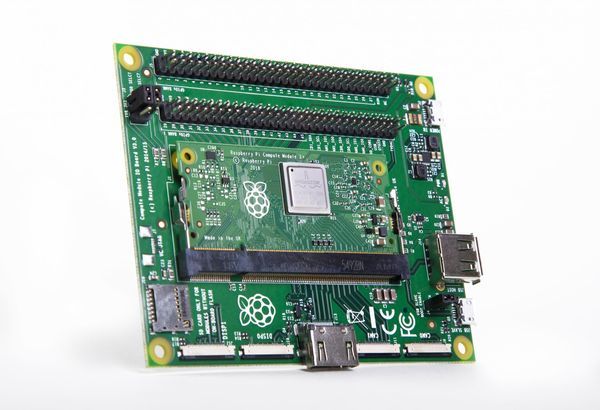
Compute Module 3+ on sale now from $25
"Today we bring you the latest iteration of the Raspberry Pi Compute Module series: Compute Module 3+ (CM3+). This newest version of our flexible board for industrial applications offers over ten times the ARM performance, twice the RAM capacity, and up to eight times the Flash capacity of the original Compute Module. A long time ago… On 7 April 2014 we launched the original Compute Module (CM1), with a Broadcom BCM2835 application processor, a single-core ARM11 at 700MHz, 512MB of RAM, and 4GB of eMMC Flash. Although it seems like yesterday, that was nearly half a decade ago! At that point I had no kids, looked significantly younger (probably because I had no kids), and had more hair (fortunately I’m still better off in that department than Eben). [This is fair – Ed.]" [...]

volvo develops 3D-printed 'living seawall' to save the world's oceans from plastic pollution
"Our oceans are in distress One garbage truck of plastic enters the world’s oceans every minute, and more than half of Sydney’s shoreline is artificial. Rich, vibrant habitats have been replaced with seawalls and degraded by plastic pollution. The Volvo Ocean Race has been hosting beach clean-ups all over the world to help combat plastic pollution. But while they’re important, beach clean-ups alone aren’t enough to save our oceans. There’s so much plastic in the ocean that scientists say it’s simply not feasible to remove it all. Tearing down seawalls isn’t viable either." [...]
Outras Notícias

Curiosity Says Farewell to Mars' Vera Rubin Ridge
"NASA's Curiosity rover has taken its last selfie on Vera Rubin Ridge and descended toward a clay region of Mount Sharp. The twisting ridge on Mars has been the rover's home for more than a year, providing scientists with new samples - and new questions - to puzzle over. On Dec. 15, Curiosity drilled its 19th sample at a location on the ridge called Rock Hall. On Jan. 15, the spacecraft used its Mars Hand Lens Imager (MAHLI) camera on the end of its robotic arm to take a series of 57 pictures, which were stitched together into this selfie. The "Rock Hall" drill hole is visible to the lower left of the rover; the scene is dustier than usual at this time of year due to a regional dust storm. Curiosity has been exploring the ridge since September of 2017." [...]
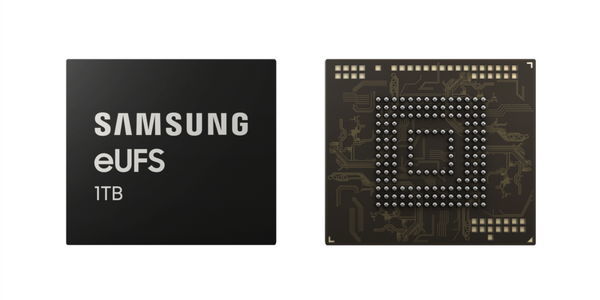
Samsung Breaks Terabyte Threshold for Smartphone Storage with Industry's First 1TB Embedded Universal Flash Storage
"Powered by the company’s fifth-generation V-NAND, the new Universal Flash Storage offers 20x more storage than a 64GB internal memory and 10x the speed of a typical microSD card for data-intensive applications Samsung Electronics, the world leader in advanced memory technology, today announced that it has begun mass producing the industry’s first one-terabyte (TB) embedded Universal Flash Storage (eUFS) 2.1, for use in next-generation mobile applications. Just four years after introducing the first UFS solution, the 128-gigabyte (GB) eUFS, Samsung has passed the much-anticipated terabyte threshold in smartphone storage. Smartphone enthusiasts will soon be able to enjoy storage capacity comparable to a premium notebook PC, without having to pair their phones with additional memory cards. “The 1TB eUFS is expected to play a critical role in bringing a more notebook-like user experience to the next generation of mobile devices,” said Cheol Choi, executive vice president of Memory Sales & Marketing at Samsung Electronics. “What’s more, Samsung is committed to assuring the most reliable supply chain and adequate production quantities to support the timely launches of upcoming flagship smartphones in accelerating growth of the global mobile market.” Within the same package size (11.5mm x 13.0mm), the 1TB eUFS solution doubles the capacity of the previous 512GB version by combining 16 stacked layers of Samsung’s most advanced 512-gigabit (Gb) V-NAND flash memory and a newly developed proprietary controller. Smartphone users will now be able to store 260 10-minute videos in 4K UHD (3840×2160) format, whereas the 64GB eUFS widely used in many current high-end smartphones is capable of storing 13 videos of the same size." [...]

Bluetooth Enhances Support for Location Services with New Direction Finding Feature
"The Bluetooth Special Interest Group (SIG) today announced a new direction finding feature that holds the potential to significantly enhance the performance of Bluetooth location services solutions. The new feature allows devices to determine the direction of a Bluetooth signal, thereby enabling the development of Bluetooth proximity solutions that can understand device direction as well as Bluetooth positioning systems that can achieve down to centimeter-level location accuracy. Bluetooth location services solutions generally fall into two categories; proximity solutions and positioning systems. Today, proximity solutions use Bluetooth to understand when two devices are near each other, and approximately how far apart. They include item finding solutions such as personal property tags, as well as point-of-interest (PoI) information solutions like proximity marketing beacons. By including the new direction finding feature, Bluetooth proximity solutions can add device direction capability." [...]

Maxim’s Highly Integrated, Single-Chip Security Solutions Offer Simple Implementation While Safeguarding Sensitive IoT Data
"MAX36010 and MAX36011 security supervisors provide robust tamper detection and cryptography with 60 percent faster design cycle and 20 percent lower BOM costs Designers of internet of things (IoT) devices now have a smarter and more secure way to protect stored, sensitive information with the highly integrated MAX36010 and MAX36011 single-chip security supervisors from Maxim Integrated Products, Inc. (NASDAQ: MXIM). These security solutions make it easier for designers to implement robust tamper detection, cryptography and secure storage while safeguarding sensitive information via logical and physical protections, without having to be security experts themselves. Details about MAX36010 › Details about MAX36011 › The MAX36010 and MAX36011 both offer strong security that can be easily integrated into a design at any stage of its development. Additionally, if these parts are integrated later in the design cycle, there is no need to change the platform to accommodate them, thereby simplifying the implementation process. Compared to competitive solutions, the devices, due to their high level of integration, facilitate a 60 percent faster design cycle, while also lowering bill of materials (BOM) costs by 20 percent. To ensure a higher level of security, these supervisors generate keys via a true random number generator (TRNG)." [...]
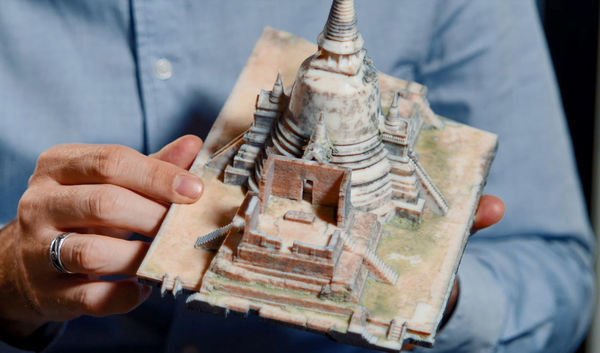
3D Printed Realism from Stratasys Helps Bring Ancient Artifacts to Life
"Underscoring the power of realism in 3D printed models, Stratasys (Nasdaq: SSYS) and Google Arts and Culture are re-imagining some of the world’s most cherished artifacts and historical monuments through additive manufacturing. Backed by advanced color and multi-material functionality of the Stratasys J750 3D Printer, historians can now re-create these items digitally and physically – raising both awareness and accessibility of ancient history. Google Arts and Culture is capitalizing on Stratasys technology for its Open Heritage Project - designing and creating historical pieces with multi-material and multi-color 3D printed prototypes. With 3D printing, these remains can be more effectively preserved and shared– with files available for download around the world. The result is enhanced accessibility, in-depth understanding, and enriched appreciation of centuries-old cultures. “The project was to explore physically making these artifacts in an effort to get people hooked and excited about seeing pieces in a museum or research context." [...]
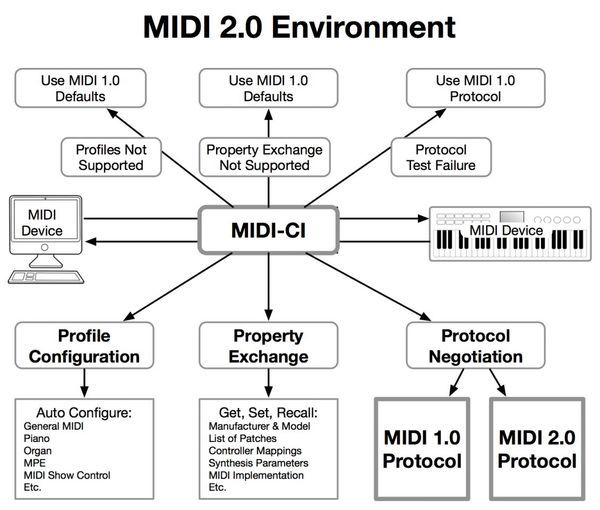
The MIDI Manufacturers Association (MMA) and the Association of Music Electronics Industry (AMEI) announce MIDI 2.0 Prototyping
"The MIDI Manufacturers Association (MMA) and AMEI (the Japanese MIDI association) have finalized the core features and name for the next generation MIDI protocol: MIDI 2.0. Member companies are currently working together to develop prototypes based on a jointly developed, feature-complete, draft specification. A members-only plugfest to test compatibility between some early MIDI 2.0 prototypes is planned for Winter NAMM 2019. Participating companies include Ableton/Cycling '74, Art+Logic, Bome Software, Google, imitone, Native Instruments, Roland, ROLI, Steinberg, TouchKeys, and Yamaha. As with MIDI 1.0, AMEI and the MMA are working closely together and sharing code to streamline the prototype development process. Prototyping is planned to continue during 2019 as the associations work together on MIDI 2.0 launch plans, including exploring the development of a MIDI 2.0 logo and self-certification program for MMA and AMEI member companies." [...]

Intel Xeon W-3175X Processor Available: Powerhouse Built for the Most Demanding Professional Applications
" The Intel® Xeon® W-3175X processor is available today. This unlocked1 28-core workstation powerhouse is built for select, highly-threaded and computing-intensive applications such as architectural and industrial design and professional content creation. Built for handling heavily threaded applications and tasks, the Intel Xeon W-3175X processor delivers uncompromising single- and all-core world-class performance for the most advanced professional creators and their demanding workloads. Why It’s Different: With the most cores and threads, CPU PCIe lanes, and memory capacity of any Intel desktop processor, the Intel Xeon W-3175X processor has the features that matter for massive mega-tasking projects such as film editing and 3D rendering. Other key features and capabilities: Intel® Mesh Architecture, which delivers low latency and high data bandwidth between CPU cores, cache, memory and I/O while increasing the number of cores per processor – a critical need for the demanding, highly-threaded workloads of creators and experts. Intel® Extreme Tuning Utility, a precision toolset that helps experienced overclockers optimize their experience with unlocked1processors." [...]

Nano-Quiescent, High-Efficiency Step-Down Converters from STMicroelectronics Save Energy and Space in IoT Devices
"STMicroelectronics’ ST1PS01 step-down converters are engineered for small size, low quiescent current, and high efficiency at all values of load current, to save energy and real-estate in keep-alive point-of-load supplies and IoT devices such as asset trackers, wearables, smart sensors, and smart meters. Nano-Quiescent, High-Efficiency Step-Down Converters from STMicroelectronics Save Energy and Space in IoT Devices Leveraging synchronous rectification, efficiency is 92% at 400mA full load and 95% when delivering just 1mA. Power-saving design features keep the quiescent current to a miserly 500nA and include a low-power voltage reference. There is also a pulse-frequency counter for controlling converter current at light load, with two high-speed comparators to help minimize output ripple. Integrated feedback-loop compensation, soft-start circuitry, and power switches ensure a space-saving solution that requires just a few small-outline passives to complete the circuit. The typical inductor value is 2.2µH." [...]
Ciência e Tecnologia
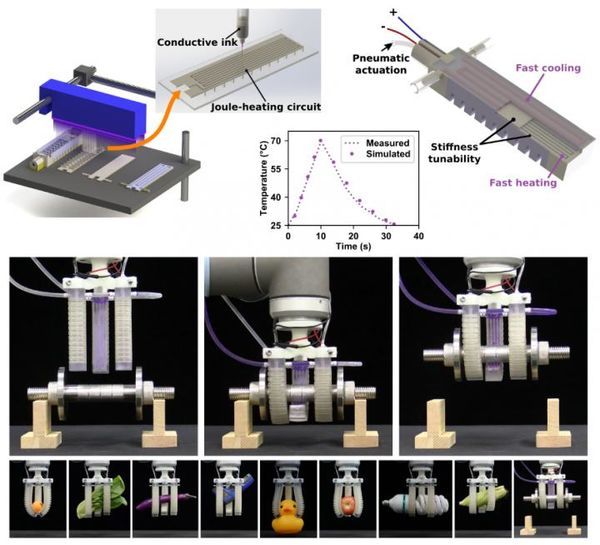
Multimaterial 3D printing used to develop Fast Response Stiffness-tunable Soft Actuator
"In search of stiffness-tunable materials that help increase the load capacity of soft robotic systems without sacrificing their compliance during robot-object interaction, thermally activated shape memory polymers (SMPs) stand out as a promising candidate. Not only are SMPs capable of reversibly changing stiffness by two to three orders of magnitude, they are also compatible with 3D printing. However, thus far it has been reported that SMP-based soft actuators generally suffer from limitations such as slow responses, small deformations and difficulties in automated fabrications with microfeatures. Researchers from the Singapore University of Technology and Design (SUTD) and Shanghai Jiao Tong University (SJTU) recently proposed a paradigm to use finite-element simulations and hybrid multimaterial 3D printing to design and manufacture fast-response, stiffness-tunable (FRST) soft actuators which are able to complete a softening-stiffening cycle within 32 seconds. “We combine a commercial inkjet multimaterial 3D printing technology with the direct-ink writing approach to fabricate our fully printed FRST actuator,” said Assistant Professor Qi (Kevin) Ge from SUTD’s Science and Math Cluster, who is one of the co-leaders of this project. “The stiffness tunability is provided by an embedded SMP layer, and the fast response is enabled by embedded heating and cooling elements.” In fact, the integration of the SMP layer into the actuator body enhances its stiffness by up to 120 times without sacrificing flexibility and adaptivity." [...]
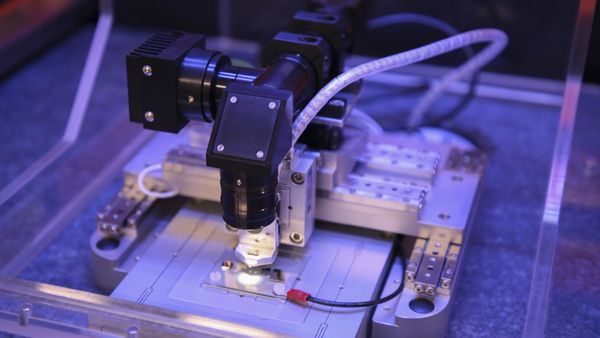
Breakthrough Reported in Fabricating Nanochips
"In the Quest for Smaller, Faster 2D Processors, NYU Tandon-Led Research Team Invents Thermal Lithography Process for Higher Quality, Lower Cost, and Mass Production Potential An international team of researchers has reported a breakthrough in fabricating atom-thin processors — a discovery that could have far-reaching impacts on nanoscale chip production and in labs across the globe where scientists are exploring 2D materials for ever-smaller and -faster semiconductors. The team, headed by New York University Tandon School of Engineering Professor of Chemical and Biomolecular Engineering Elisa Riedo, outlined the research results in the latest issue of Nature Electronics. They demonstrate that lithography using a probe heated above 100 degrees Celsius outperformed standard methods for fabricating metal electrodes on 2D semiconductors such as molybdenum disulfide (MoS₂). Such transitional metals are among the materials that scientists believe may supplant silicon for atomically small chips. The team’s new fabrication method — called thermal scanning probe lithography (t-SPL) — offers a number of advantages over today’s electron beam lithography (EBL). First, thermal lithography significantly improves the quality of the 2D transistors, offsetting the Schottky barrier, which hampers the flow of electrons at the intersection of metal and the 2D substrate." [...]
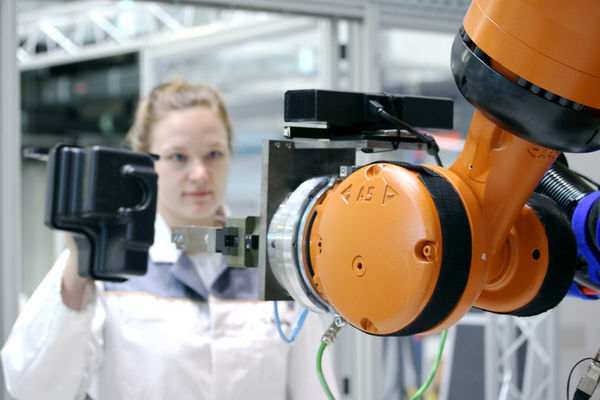
Interactive control to guide industrial robots
"Scientists at the Fraunhofer Institute for Machine Tools and Forming Technology IWU have developed an innovative technology enabling people and large industrial robots to work together in an intuitive way that feels a lot like human teamwork. Using the benefit of this technology, robots can recognize gestures, faces and postures to make this collaboration that much safer and more efficient. Fraunhofer IWU is set to present this innovation at the Hannover Messe Preview in hall 19 on January 24, 2019, and at the Hannover Messe in hall 17 at booth C24 from April 1 through 5, 2019. A cursory glance at shop floors is all it takes to see human-robot collaboration has gone mainstream in manufacturing. However, a second glance reveals that this is more “to each his own” than “we're in this together.” Heavy-duty robots operate alongside their human coworkers without safety fencing, but direct interaction is a no-go. Safety precautions dictate that the robot freezes as soon as a human sets foot in a sizable surrounding safety zone." [...]
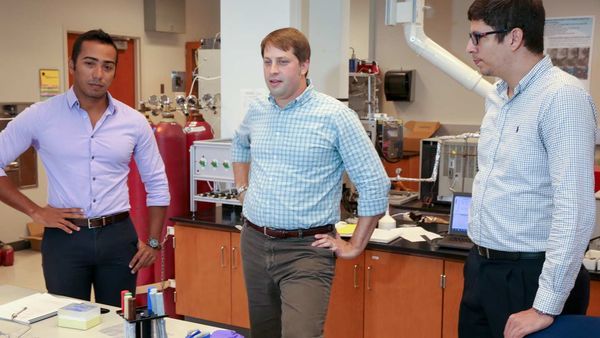
Sodium ion battery research could power up renewable energy storage
"Longer life and increased capacity for a new technology battery that could be the workhorse of a renewable energy grid are the goals of a study of the effect of charging cycles on the structure of anodes in sodium ion batteries. Under a three-year, $233,000 grant from the National Science Foundation (NSF), a team led by Dr. George Nelson, an associate professor of mechanical and aerospace engineering at The University of Alabama in Huntsville (UAH), will use X-ray diffraction and multiscale X-ray imaging to study changes in the microstructure of the tin-based anodes –also known as negative electrodes – that affect the battery’s longevity and storage capability. "As with most batteries, there is a desire to increase the capacity of sodium ion batteries. Unfortunately, high capacity battery materials like tin expand a lot when fully charged with sodium," says Dr. Nelson. "We're using a combination of experiments and numerical models to understand exactly how these changes affect battery performance, so future battery engineers can design the materials and microstructures to make better sodium ion batteries," he says. Experiments include electrochemical testing, X-ray diffraction to characterize crystal structure of electrode materials and in operando X-ray tomography." [...]

Graphene sensors can hear your brain whisper
"A newly developed graphene-based implant can record electrical activity in the brain at extremely low frequencies and over large areas, unlocking the wealth of information found below 0.1 Hz. This technology, which will be showcased in the Graphene Pavilionat Mobile World Congress in Barcelona (25-28 February 2019) was developed by Graphene Flagship partners at the Barcelona Microelectronics Institute (IMB-CNM, CSIC), the Catalan Institute of Nanoscience and Nanotechnology (ICN2), and ICFO. The prototype was adapted for brain recordings in a collaboration with the Biomedical Research Institute ‘August Pi i Sunyer’ (IDIBAPS). The study, just published in Nature Materials, describes how this ground-breaking technology will enhance our understanding of the brain and pave the way for the next generation of brain-computer interfaces. The body of knowledge about the human brain is keeps growing, but many questions remain unanswered. Researchers have been using electrode arrays to record the brain's electrical activity for decades, mapping activity in different brain regions to understand what it looks like when everything is working, and what is happening when it is not." [...]
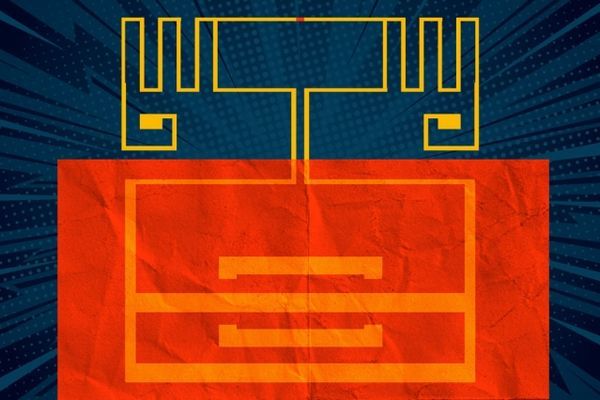
Converting Wi-Fi signals to electricity with new 2-D materials
"Device made from flexible, inexpensive materials could power large-area electronics, wearables, medical devices, and more. Imagine a world where smartphones, laptops, wearables, and other electronics are powered without batteries. Researchers from MIT and elsewhere have taken a step in that direction, with the first fully flexible device that can convert energy from Wi-Fi signals into electricity that could power electronics. Devices that convert AC electromagnetic waves into DC electricity are known as “rectennas.” The researchers demonstrate a new kind of rectenna, described in a study appearing in Nature today, that uses a flexible radio-frequency (RF) antenna that captures electromagnetic waves — including those carrying Wi-Fi — as AC waveforms. The antenna is then connected to a novel device made out of a two-dimensional semiconductor just a few atoms thick. The AC signal travels into the semiconductor, which converts it into a DC voltage that could be used to power electronic circuits or recharge batteries." [...]
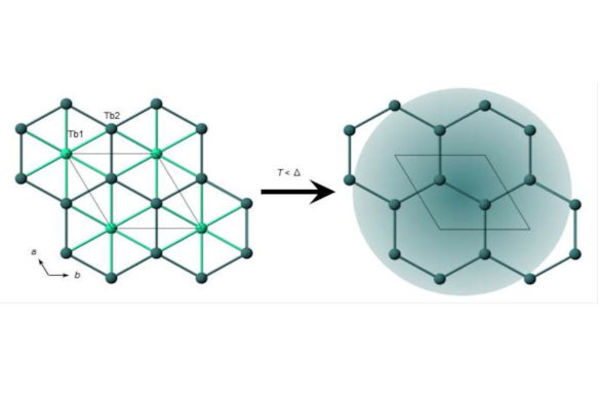
Scientists discover new quantum spin liquid
"An international research team led by the University of Liverpool and McMaster University has made a significant breakthrough in the search for new states of matter. In a study published in the journal Nature Physics, researchers show that the perovskite-related metal oxide, TbInO3, exhibits a quantum spin liquid state, a long-sought-after and unusual state of matter. Using cutting-edge experimental technologies, including inelastic neutron scattering and muon spectroscopy, researchers discovered that the exotic quantum state in TbInO3 emerges from the complexity of the local environment around the magnetic ions in the material, in this case, of the rare-earth element terbium. The discovery came as a surprise to the team as TbInO3 is a material not expected to display such unusual magnetic behaviour based on its crystal structure. The quantum spin liquid state was theoretically proposed over forty years ago by the Nobel laureate Philip Anderson. In quantum spin liquids, magnetic moments behave like a liquid and do not freeze or order even at absolute zero, giving rise to several extraordinary materials properties." [...]
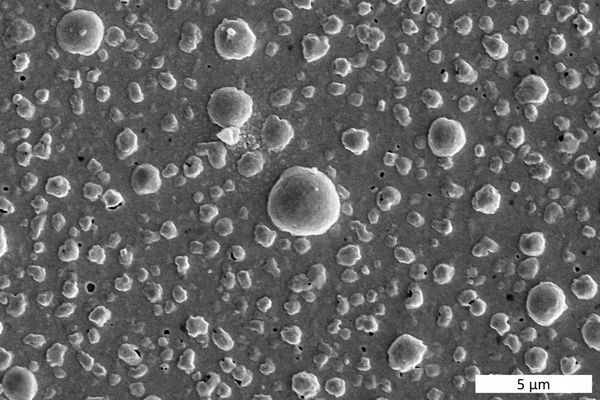
Platinum Forms Nano-Bubbles
"Technologically important noble metal oxidises more readily than expected Platinum, a noble metal, is oxidised more quickly than expected under conditions that are technologically relevant. This has emerged from a study jointly conducted by the DESY NanoLab and the Vienna University of Technology. Devices that contain platinum, such as the catalytic converters used to reduce exhaust emissions in cars, can suffer a loss in efficacy as a result of this reaction. The team around principal author Thomas Keller, from DESY and the University of Hamburg, is presenting its findings in the journal Solid State Ionics. The result is also a topic at the users' meeting of DESY's X-ray light sources with more than 1000 participants currently taking place in Hamburg. “Platinum is an extremely important material in technological terms,” says Keller." [...]
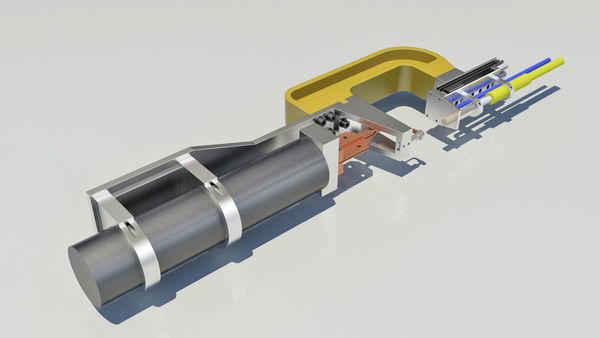
Joining gun bonds metal and plastic within seconds
"Scientists at the Fraunhofer Institute for Material and Beam Technology IWS in Dresden have developed a joining gun that creates a connection between metal and thermoplastic materials within seconds. This gun is of a modular design and can easily be integrated into the production process, for example by mounting on a robot arm in place of a spot welding gun. At the preview leading up to the Hanover Trade Fair on January 24, 2019 on the trade fair grounds in Hall 19, scientist Annett Klotzbach will be demonstrating the advantages of the joining gun. The HeatPressCool-Integrative process HPCI The connection of plastics and metals poses a challenge, due to the different physical properties of the two materials. All conventional joining options, such as bonds using adhesives or rivets have their disadvantages: adhesives need time to harden, which delays further processing. Plastics can be easily damaged during riveting." [...]
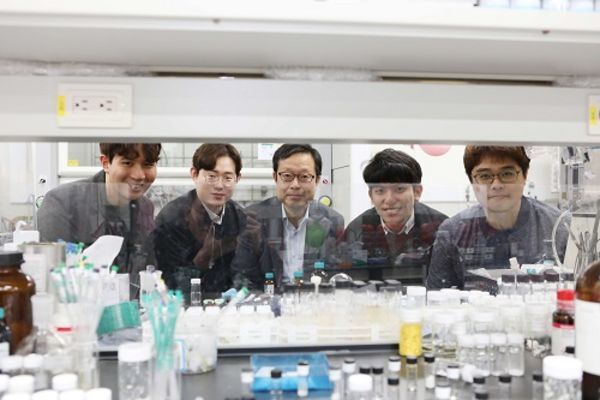
KAIST Introduces a Novel Material for Transparent and Flexible Displays
"The next generation of flexible and transparent displays will require a high-performing and flexible polymeric material that has the optical and thermal properties of glass. The material must be transparent to visible light and have a low coefficient of thermal expansion (CTE). Unfortunately, such a polymeric material has not been available. A KAIST research team has succeeded in making a new polymeric material with an exceptionally low CTE value while retaining high transparency and excellent thermal and mechanical properties. The method developed for amorphous polymers with a controlled CTE can be applied to control the thermal expansion of organic materials as well. Most of objects expands upon heating and shrinks by cooling, and organic polymers have a relatively large CTE compared to that of ceramics or metals." [...]

MIT robot combines vision and touch to learn the game of Jenga
"In the basement of MIT’s Building 3, a robot is carefully contemplating its next move. It gently pokes at a tower of blocks, looking for the best block to extract without toppling the tower, in a solitary, slow-moving, yet surprisingly agile game of Jenga. The robot, developed by MIT engineers, is equipped with a soft-pronged gripper, a force-sensing wrist cuff, and an external camera, all of which it uses to see and feel the tower and its individual blocks. As the robot carefully pushes against a block, a computer takes in visual and tactile feedback from its camera and cuff, and compares these measurements to moves that the robot previously made. It also considers the outcomes of those moves — specifically, whether a block, in a certain configuration and pushed with a certain amount of force, was successfully extracted or not. In real-time, the robot then “learns” whether to keep pushing or move to a new block, in order to keep the tower from falling." [...]

Researchers at TU Dresden make breakthrough in understanding electrical conductivity in doped organic semiconductors
"Researchers from the Dresden Integrated Center for Applied Physics and Photonic Materials (IAPP) and the Center for Advancing Electronics Dresden (cfaed) at TU Dresden, in cooperation with Stanford University (USA) and the Institute for Molecular Science in Okazaki (Japan), have identified the key parameters that influence electrical conductivity in doped organic conductors. Organic semiconductors enable the fabrication of large-scale printed and mechanically flexible electronic applications, and have already successfully established themselves on the market for displays in the form of organic light-emitting diodes (OLEDs). In order to break into further market segments, however, improvements in performance are still needed. Doping is the answer. In semiconductor technology, doping refers to the targeted introduction of impurities (also called dopants) into the semiconductor material of an integrated circuit. These dopants function as intentional "disturbances" in the semiconductor that can be used to specifically control the behaviour of the charge carriers and thus the electrical conductivity of the original material." [...]
Semiconductor for making the thin-film transistors that everyone's been looking for!
"Scientists at Dongguk University have found a way to create printed p-channel thin-film transistors by using the abundantly available and environmentally friendly copper(I) iodide semiconductor at room temperature. Their energy-efficient and cost-effective fabrication method for these transistors may pave the way for developing low-cost and novel optoelectronic devices. Transistors are the building blocks of most of the electronic devices we use every day, and research on fabricating new types of semiconducting materials for thin-film transistors (TFIs) has been ongoing for decades. Whenever new transistors or novel fabrication methods are discovered, many previously impossible applications become feasible, such as ultrahigh-definition transparent displays and flexible electronic devices. Nowadays, there is a huge demand for p-type transparent semiconductors (which are conductive due to the movement of charge carriers called “holes”) for making p-channel transistors, but when compared to the n-type counterparts, their use is limited by chemical instability and poor electric properties. To overcome these limitations, a research team at Dongguk University led by Prof. Yong-Young Noh focused on developing a p-type transparent semiconductor for TFTs using a metal halide like copper(I) iodide (CuI), instead of metal oxide." [...]
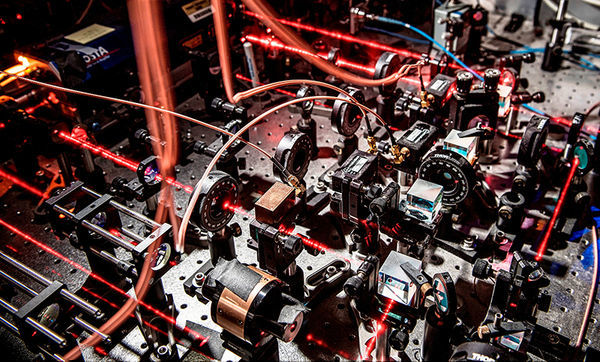
New quantum system could help design better spintronics
"Researchers have created a new testing ground for quantum systems in which they can literally turn certain particle interactions on and off, potentially paving the way for advances in spintronics. Spin transport electronics have the potential to revolutionize electronic devices as we know them, especially when it comes to computing. While standard electronics use an electron’s charge to encode information, spintronic devices rely on another intrinsic property of the electron: its spin. Spintronics could be faster and more reliable than conventional electronics, as these devices use less power. However, the field is young and there are many questions researchers need to solve to improve their control of spin information. One of the most complex questions plaguing the field is how the signal carried by particles with spin, known as spin current, decays over time." [...]
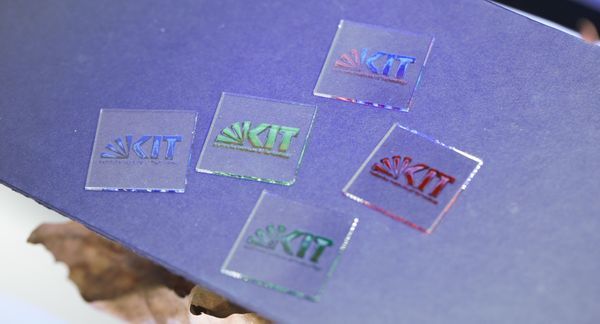
Photovoltaics - Versatile in Shape and Color
"The goal of PRINTPERO is to develop digitally printed, highly efficient and stable solar modules that can be integrated into roofs, facades, and windows. In the project coordinated at the Karlsruhe Institute of Technology (KIT), German and Greek researchers and industrial partners are demonstrating the technological feasibility of solar modules based on perovskite absorbers. They work on prototypes that can be freely designed in size, shape, and color. The Federal Ministry of Education and Research supports the project within the framework program Research for Sustainable Development (FONA). Perovskite semiconductors are currently among the most promising materials for highly efficient and cost-effective next-generation solar modules. Thin-film solar cells based on these perovskites already achieve efficiencies of more than 23 percent in the laboratory." [...]

Researchers Develop a New Self-Assembling Nanomaterial that Offers a Promising Pathway to More Efficient, Affordable Harnessing of Solar Power
"The materials produce a singlet fission reaction that creates more and extends the life of harvestable electronic charges Solar rays are a plentiful, clean source of energy that is becoming increasingly important as the world works to shift away from power sources that contribute to global warming. But current methods of harvesting solar charges are expensive and inefficient—with a theoretical efficiency limit of 33 percent. New nanomaterials developed by researchers at the Advanced Science Research Center (ASRC) at The Graduate Center of The City University of New York (CUNY) could provide a pathway to more efficient and potentially affordable harvesting of solar energy. The materials, created by scientists with the ASRC’s Nanoscience Initiative, use a process called singlet fission to produce and extend the life of harvestable light-generated electrons. The discovery is described in a newly published paper in the Journal of Physical Chemistry. Early research suggests these materials could create more usable charges and increase the theoretical efficiency of solar cells up to 44 percent." [...]

All-in-one transparent transistors
"Small tweaks in component ratios generate electronically different layers from the same material to create transparent transistors. Worldwide demand is growing for transparent conducting oxides for use in solar cells, flat panel displays, smart windows and semiconductor-based consumer electronics. KAUST researchers have engineered a zinc-oxide-based transparent material that displays tunable electronic properties depending on the tweaking of a new type of dopant. Transparent electronics rely on indium tin oxide, a transparent and electrically conductive material that has an exorbitant cost due to the scarcity of indium. Zinc-oxide-based materials, such as hafnium-doped zinc-oxide materials, are expected to offer affordable, green and abundant alternatives to indium tin oxide. However, hafnium-doped zinc-oxide materials typically require high deposition temperatures and display inadequate performance for real-life device applications." [...]

Reinforcement learning steps robotic prosthetics forward
"Researchers from Arizona State University, North Carolina State University and the University of North Carolina have developed an intelligent system for “tuning” powered prosthetic knees, allowing users to walk comfortably with the prosthetic device in minutes rather than hours. The system is the first to rely solely on reinforcement learning to tune a robotic prosthesis. Jennie Si, a professor in the School of Electrical, Computer and Energy Engineering in ASU’s Ira A. Fulton Schools of Engineering, co-authored a paper released this week in the journal IEEE Transactions on Cybernetics. Using the reinforcement learning framework, Si developed the algorithm that essentially “teaches” a prosthetic device to adapt to a user’s normal walking gait using data collected from a suite of sensors in the device and the person’s natural walking pattern. Normally when someone receives a robotic prosthetic knee, a human practitioner works with them to modify a handful of parameters to specifically accommodate their walking gait. The process can take hours." [...]
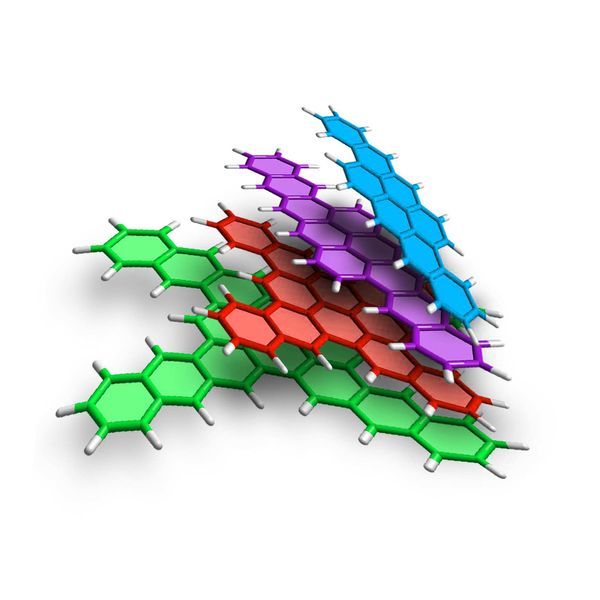
Large, stable pieces of graphene produced with unique edge pattern
"Graphene is a promising material for use in nanoelectronics. Its electronic properties depend greatly, however, on how the edges of the carbon layer are formed. Zigzag patterns are particularly interesting in this respect, but until now it has been virtually impossible to create edges with a pattern like this. Chemists and physicists at FAU have now succeeded in producing stable nanographene with a zigzag edge. Not only that, the method they used was even comparatively simple. Their research, conducted within the framework of collaborative research centre 953 – Synthetic Carbon Allotropes funded by the German Research Foundation (DFG), has now been published in the journal Nature Communications*." [...]

NIST Reveals 26 Algorithms Advancing to the Post-Quantum Crypto 'Semifinals'
"The field has narrowed in the race to protect sensitive electronic information from the threat of quantum computers, which one day could render many of our current encryption methods obsolete. As the latest step in its program to develop effective defenses, the National Institute of Standards and Technology (NIST) has winnowed the group of potential encryption tools—known as cryptographic algorithms—down to a bracket of 26. These algorithms are the ones NIST mathematicians and computer scientists consider to be the strongest candidates submitted to its Post-Quantum Cryptography Standardization project, whose goal is to create a set of standards for protecting electronic information from attack by the computers of both tomorrow and today. “These 26 algorithms are the ones we are considering for potential standardization, and for the next 12 months we are requesting that the cryptography community focus on analyzing their performance,” said NIST mathematician Dustin Moody. “We want to get better data on how they will perform in the real world.” Currently, the security of some cryptographic algorithms—which protect everything from online banking transactions to people’s online identities and private email messages—relies on the difficulty conventional computers have with factoring large numbers. Quantum computers are still in their infancy, but their design—which draws upon very different scientific concepts than conventional computers—may eventually enable them to factor these large numbers relatively quickly, revealing our secrets." [...]

Research Team Led by SNU College of Engineering Professor Jang Wook Choi Develops a Next Generation Aluminum Secondary Battery System
"SNU College of Engineering announced on 10th that Professor Jang Wook Choi of the Department of Chemical and Biological Engineering with Professor J. Fraser Stoddart from Northwestern University, the recipient of 2016 Nobel Prize in Chemistry, teamed up for a joint-research to develop the next generation aluminum secondary battery system. The recent wide use of electricity-based transportation like the electric car and drone has called for a high demand of secondary batteries. However, the price rise of lithium and transition metals used in commercialized lithium ion batteries has led to an increase of cost burden along with the rise of demand. To overcome this limitation, the research team focused on aluminum, which is a much more affordable material with greater capacity. However, one critical fallback of aluminum ion is that it destroys the structure of most oxides; thus, finding a suiting rechargeable bipolar substance is difficult. Hence, the team departed from the conventional oxides to turn toward stable organic substance that hosts aluminum complex ions." [...]
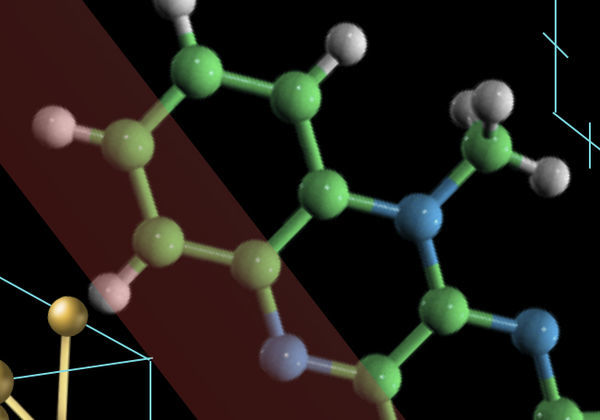
Quantum sensors providing magnetic resonance with unprecedented sensitivity
"The QUTIS group at the UPV/EHU has participated in a piece of international research together with the CSIC and the University of Ulm in Germany A piece of work involving international collaboration and the participation of the Quantum Technologies for Information Science (QUTIS) group of the UPV/EHU’s Department of Physical Chemistry, has produced a series of protocols for quantum sensors that could allow images to be obtained by means of the nuclear magnetic resonance of single biomolecules using a minimal amount of radiation. The results of the research have been published in the prestigious interdisciplinary physics journal Physical Review Letters. Nuclear magnetic resonance (NMR) is the technique behind a variety of applications, such as medical imaging, neuroscience or detection of drugs and explosives. With the help of quantum sensors, NMR has been adapted to work in the nanoscale regime, where it has both the potential to impact many disciplines, such as life sciences, biology, medicine, and to provide measurements of incomparable precision and sensitivity. In particular, “we expect that the combination of quantum sensors and dynamical decoupling techniques allows NMR imaging of single biomolecules” said the authors, among which are Dr. Jorge Casanova (Ikerbasque researcher) and Ikerbasque Professor Enrique Solano, at the Quantum Technologies for Information Science (QUTIS) group of the UPV/EHU’s Department of Physical Chemistry, as well as researchers of the CSIC, and the University of Ulm (Germany). This quantum-enhanced NMR “will be able to resolve chemical shifts in tiny picoliter samples, producing biosensors with unparalleled sensitivity and providing new insights into the structure, dynamics, and function of biomolecules and biological processes”, they added." [...]
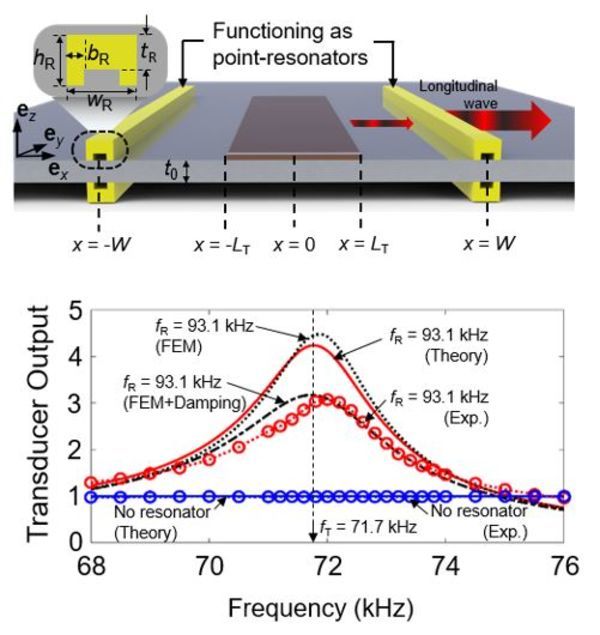
Research Team Led by SNU Professor Yoon Young Kim Develops an Ultra-Sensitive Vibration and Supersonic Wave Sensor Technology
"Opens a New Prospect in Sensor Technology for Fault Diagnosis of Machinery, Non-Destructive Testing, and IoT Korean researchers developed a technology that can significantly amplify vibrations and ultrasonic signals used to detect abnormalities in mechanical devices and structures. SNU College of Engineering (Dean Kook Heon Char) announced on 13th that research team led by Professor Yoon Young Kim of the Department of Mechanical and Aerospace Engineering has developed a new technology that greatly amplifies sensor signals by adding a pair of resonators to where the vibrational and ultrasonic wave sensors are attached. Conventional sensor signal amplification technology faced limitation as related researches narrowed themselves to only the sensor itself. However, Kim’s team led a paradigm shift to widen their view and use metamaterials to reduce the effective mechanical resistance around the sensor to hence amplify the signal. The team demonstrated with experiments that the signal of piezoelectric sensor, a sensor commonly used for measuring vibration and supersonic signals, can be amplified more than 300% using this newly-developed technology. The technology is expected to have a wide range of application beyond sensing like vibrational and ultrasonic excitation." [...]

Waterproof graphene electronic circuits
"Water molecules distort the electrical resistance of graphene, but a team of European researchers has discovered that when this two-dimensional material is integrated with the metal of a circuit, contact resistance is not impaired by humidity. This finding will help to develop new sensors with a significant cost reduction. The many applications of graphene, an atomically thin sheet of carbon atoms with extraordinary conductivity and mechanical properties, include the manufacture of sensors. These transform environmental parameters into electrical signals that can be processed and measured with a computer. Due to their two-dimensional structure, graphene-based sensors are extremely sensitive and promise good performance at low manufacturing cost in the next years. To achieve this, graphene needs to make efficient electrical contacts when integrated with a conventional electronic circuit." [...]

Innovative new technique could pave the way for new generation of flexible electronic components
"Researchers at the University of Exeter have developed an innovative technique that could help create the next generation of everyday flexible electronics. A team of engineering experts have pioneered a new way to ease production of van der Waals heterostructures with high-K dielectrics- assemblies of atomically thin two-dimensional (2-D) crystalline materials. One such 2-D material is graphene, which comprises of a honeycomb-shaped structure of carbon atoms just one atom thick. While the advantages of van der Waals heterostructures is well documented, their development has been restricted by the complicated production methods. Now, the research team has developed a new technique that allows these structures to achieve suitable voltage scaling, improved performance and the potential for new, added functionalities by embedding a high-K oxide dielectric. The research could pave the way for a new generation of flexible fundamental electronic components." [...]
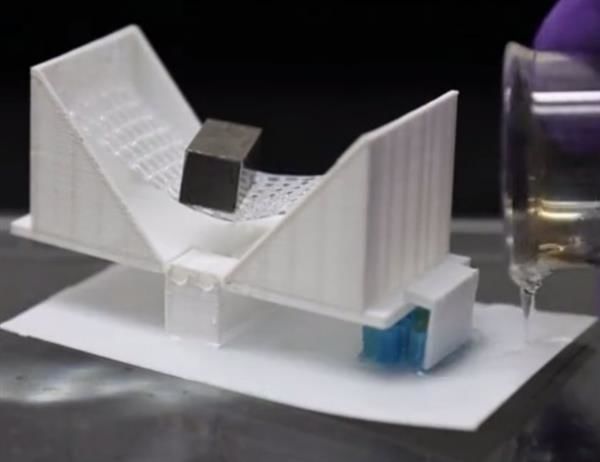
Engineers 3D print smart objects with 'embodied logic'
"Even without a brain or a nervous system, the Venus flytrap appears to make sophisticated decisions about when to snap shut on potential prey, as well as to open when it has accidentally caught something it can’t eat. Researchers at the School of Engineering and Applied Science have taken inspiration from these sorts of systems. Using stimuli-responsive materials and geometric principles, they have designed structures that have “embodied logic.” Using multi-material 3D printers, the researchers can make these active structures with nested if/then logic gates, and can control the timing of each gate, allowing for complicated mechanical behaviors in response to simple changes in the environment. For example, by utilizing these principles an aquatic pollution-monitoring device could be designed to open and collect a sample only in the presence of an oil-based chemical and when the temperature is over a certain threshold. The Penn engineers published an open access study outlining their approach in the journal Nature Communications. The study was led by Jordan Raney, an assistant professor in Penn Engineering’s Department of Mechanical Engineering and Applied Mechanics, and Yijie Jiang, a postdoctoral researcher in Raney’s lab." [...]
Modelos 3D
Com a disponibilidade de ferramentas que permitem dar azo a nossa imaginação na criação de peças 3D e espaços como o thingiverse para as publicar, esta rubrica apresenta alguns modelos selecionados que poderão ser úteis.
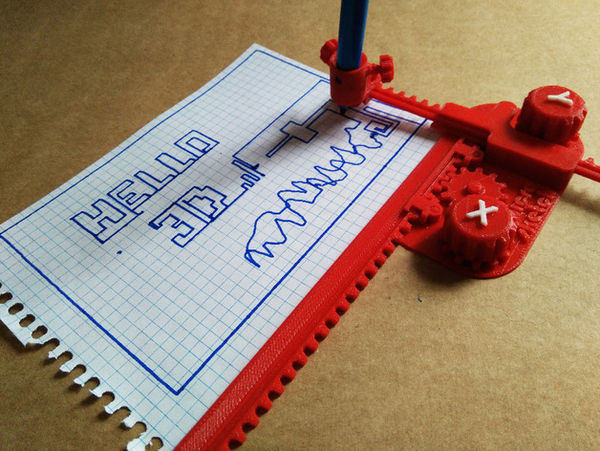
micro-sketch
"Hi! This is my printable version of the classic etch-a-sketch / telesketch. A kind of plotter-toy. You can draw what you imagine rotating the X-Y knobs. It works great with a marker or a pen. The drawing area it's 15x10cms aprox." [...]
Documentação
A documentação é parte essencial do processo de aprendizagem e a Internet além de artigos interessantes de explorar também tem alguma documentação em formato PDF interessante de ler. Todos os links aqui apresentados são para conteúdo disponibilizado livremente pelo editor do livro.
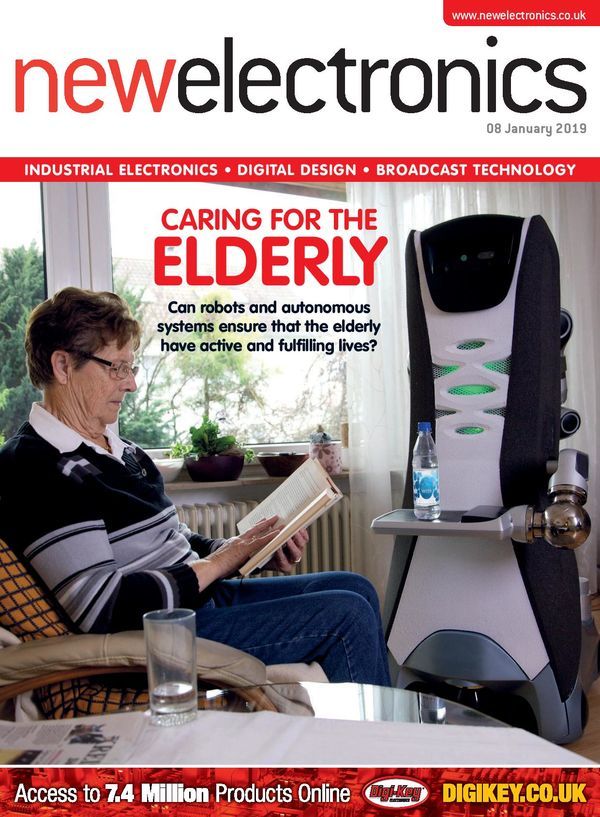
newelectronics 8 Janeiro 2019
"New Electronics is a fortnightly magazine focusing on technological innovation, news and the latest developments in the electronics sector. Downloadable as a digital page turner or pdf file, or offered as a hard copy, the New Electronics magazine is available in a format to suit you" [...]

newelectronics 22 Janeiro 2019
"New Electronics is a fortnightly magazine focusing on technological innovation, news and the latest developments in the electronics sector. Downloadable as a digital page turner or pdf file, or offered as a hard copy, the New Electronics magazine is available in a format to suit you" [...]
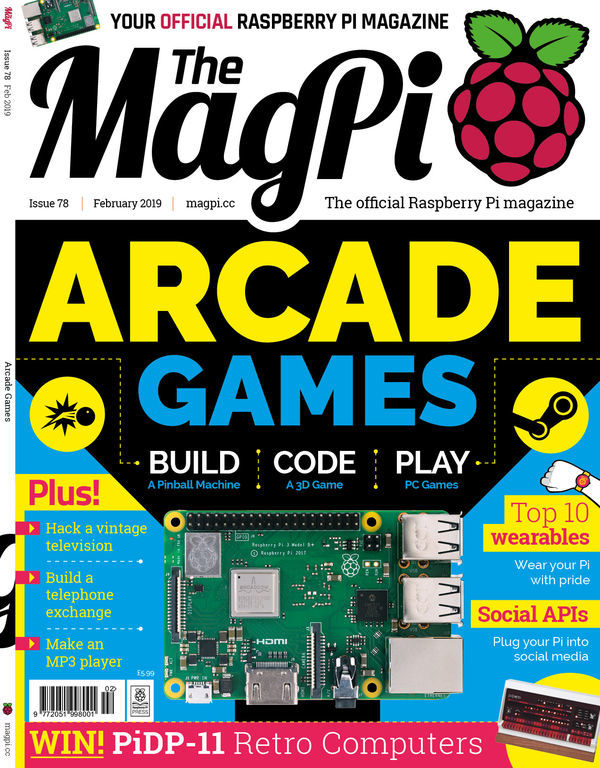
The MagPI 78
"This month we demonstrate a love of Arcade Games! We believe play is an ideal way to learn. So in the latest issue of The MagPi, you’ll find three great game projects bundled together. So power-up your coding, buff your digital making skills, and get ready to play with these fun projects. Build a Pinball Machine. Our step-by-step guide will have you making your own ball flipper in no time." [...]
Projetos Maker
Diversos Projetos interessantes.
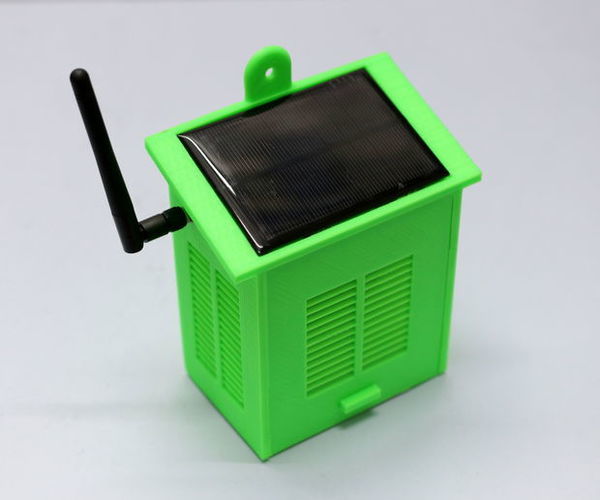
Solar Powered WiFi Weather Station V2.0
"This Instructable is a continuation to my earlier weather station project. It was quite popular on the web, people around the globe made their own by following it and given valuable feedbacks for improvement.By taking consideration in to the comments and Q&A section of my earlier project, I decided to make this new version Weather Station.I also made a custom PCB for this project, so any one with little knowledge on electronics circuit can be made this project. My V-2.0 PCB can also be used for many application in Arduino platform. Following are the salient features of new weather station. Features: 1. Connect to Wi-Fi, and upload the data to the web ( Blynk App and Thingspeak) 2." [...]
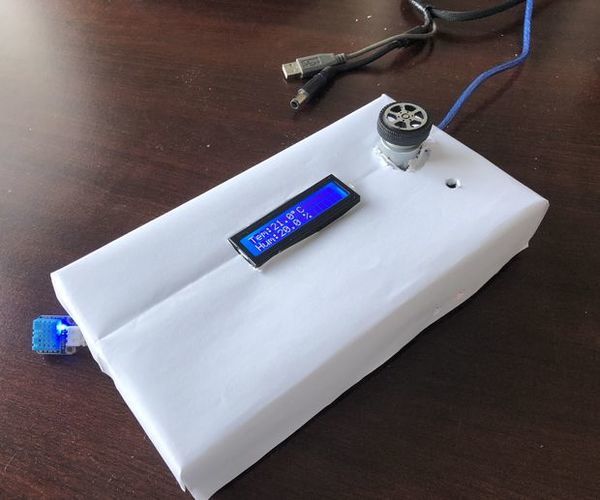
Aurdino Weather Station
"Ever wanted to make your very own Aurdino Weather station? Well, now is your chance! Through this instructable, you will learn the basics of how to build an Aurdino Weather Station as well as learn the code behind it. At the end of this project, you will have a fully-functioning weather station which is capable of sensing the temperature and humidity as well as manually blow a DC motor fan. This project will take anywhere from 45 minutes to 2 hours depending on your experience in engineering. Good luck and have fun!" [...]
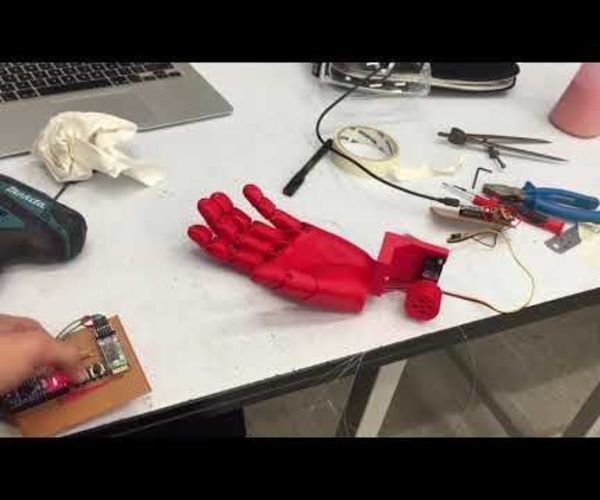
Bluetooth Remotely Controlled Robotic Hand Palm
"In this tutorial we will go through in high details and provide all of the necessary information in order to build your own bluetooth remotely controlled robotic hand palm. You can further develop it to become a whole robotic arm, if you want... This is a great project for new people getting into robotics or for school projects and will definitely help you develop some nice technical skills. After this tutorial you will have a banging robotic hand that you can handshake when no one wants to handshake you ;). Trust me it is a great thing to show off to your friends " [...]
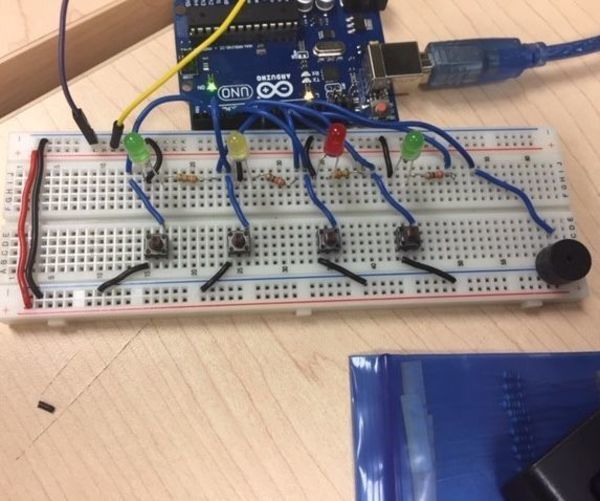
Computer Engineering Final Simon Says Game
"My Idea: My project is the Simon Says Game. In this game there are four LEDs and four buttons. Music will play from the buzzer while the LEDs light up matching the music. Then the game will start. A LED will light up and you have to click the button matching the led that lit up. If you get it right the LEDs will flash and music will play from the buzzer and if you get it wrong less will flash and different music will play from the buzzer." [...]

JustAPendulum: Open-source Digital Pendulum
"JustAPendulum is an Arduino-based open-source pendulum that measures and calculates the oscillation period to find the gravitational acceleration of the Earth (~9,81 m/s). It contains a homemade Arduino UNO that uses an USB-to-serial adapter to communicate with your computer. JustAPendulum is highly accurate and has a companion (written in Visual Basic .NET) that, in real-time, will show you the position of the mass and a table and a graph with all the precedent measures. Completely laser cut and homemade, its very easy-to-use: just push a button and let the mass fall and the board will calculate everything. Ideal for tests in physics classes! " [...]
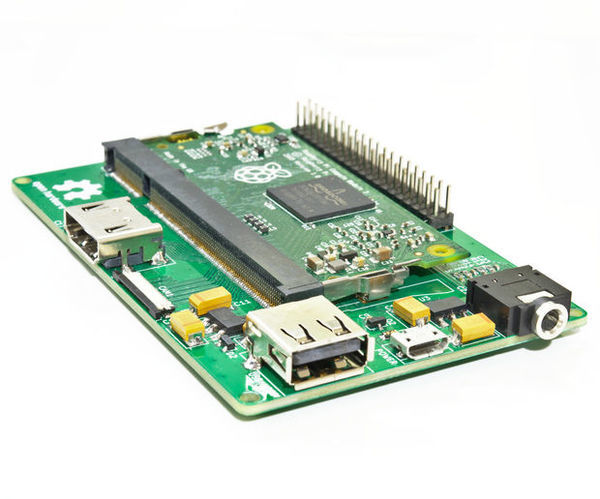
Design Your Own Raspberry Pi Compute Module PCB
"If youve never heard of the Raspberry Pi Compute Module before, its basically a fully fledged Linux computer with the form factor a laptop RAM stick! With it becomes possible to design your own custom boards where the Raspberry Pi is just another component. That gives you an enormous amount of flexibility as it allows you to have access to a much greater amount of IO pins, while the same time you get to choose exactly what hardware you want on your board. The on-board eMMC also eliminates the need for an external micro SD card, which makes the Compute Module perfect for designing Raspberry Pi based products. Unfortunately, while the Compute Module allows you to do all this it still appears to be lacking in terms of popularity compared to the traditional Raspberry Pi Model A and B. As a result, there arent many open source hardware projects out there based on it." [...]
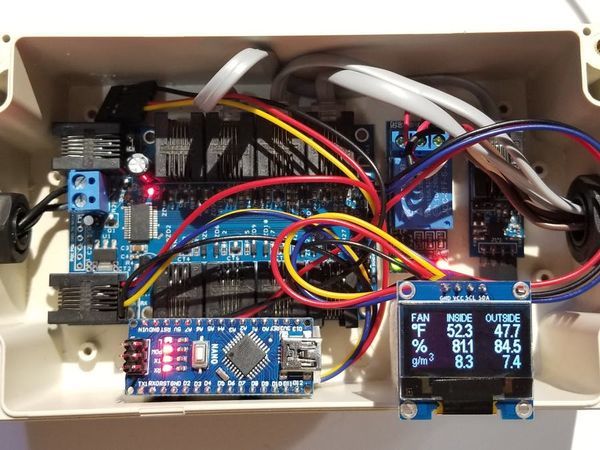
Basement/Crawlspace Ventilation System
"Intelligently reduce the moisture in your basement/crawlspace to help control mildew growth and lower your heating/cooling bill. Feature List - Inside/outside temperature/humidity sensor. - Smart vent fan control with moisture comparison - Reduce the moisture in your basement/crawlspace - Help reduce mildew growth - Smart ventilating saves power Parts Needed to Build the Ventilation System - IO Expander - 1-Wire to I2C - Arduino Nano - 1 Channel DC 5V Relay - x2 SHT10 Humidity Sensor - I2C SSD1306 OLED 128x64 Display - x2 110V 172x150x38mm 0.34A 2400 RPM Ball Bearing Fans - 158x90x65mm Clear Waterproof Plastic Enclosure - ip68 pg7 Waterproof Nylon Cable Gland - ip68 pg9 Waterproof Nylon Cable Gland - x2 RJ11 Keystone Screw Terminal Jack - x2 Keystone Enclosure - x2 50ft 4C4P RJ11 Wire - 6" 4C4P RJ11 Wire - 100ft 110VAC Wire - AC Plug - 2.54mm Header Wire - 12VDC 1A Wall Adapter Power Supply" [...]
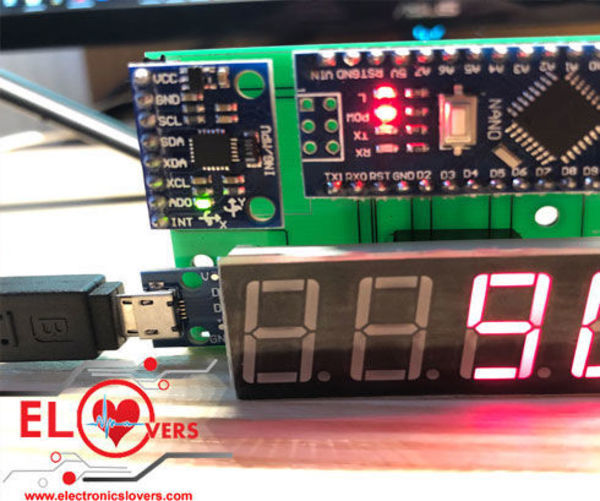
Digital Spirit Level a DIY Project Module by Electronicslovers
"There is a time when you need to mount a piece of furniture or something similar in your home and for a straight mounting everybody usual use a spirit level. ElectronicsLovers Tech Team built this module, which has one difference from a usual one: its digital. This project also comes in handy for people who are building RC Models, since there might be mandatory to acquire angles in different directions to process them further for using in different calculations like stabilizing, for example. In this project, we will use a GY-521 3 Axis Accelerometer for determining at which angle a surface is. For displaying the angle, we will use a 7 Segment 4 Digits display. The C used will be an Arduino Nano, in order to keep everything compact on PCB." [...]
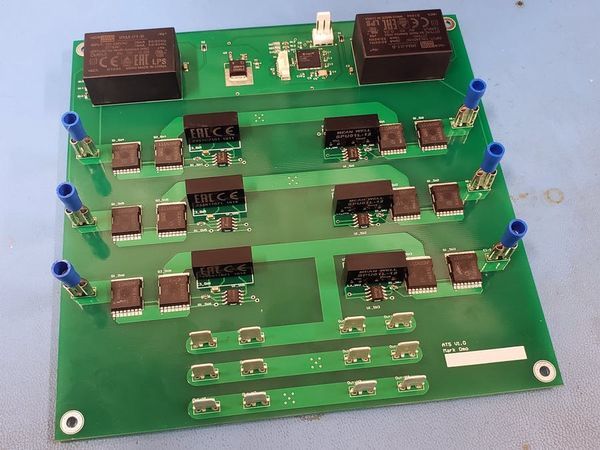
Open Source Automatic Transfer Switch
"An open source automatic transfer switch based on the Infineon CoolMOS™ C7 MOSFET. I have created the world's first open source automatic transfer switch (ATS), a device used by companies looking for the ultimate uptime for their data centers, like Facebook Google, and Amazon. High uptime data centers have more than one power company providing power to them for redundancy (if one power company has a blackout or maintenance). An automatic transfer switch automatically swaps the devices connected to it between two power inputs. Summary I set out to create the world's first open source (MIT Licensed) Automatic Transfer Switch (ATS) using Infineon's new 600V CoolMOS™ C7 Gold superjunction MOSFETs. The low RDSon means that there is no need to parallel FETs to achieve the required current handling capacity (15+A), and the high breakdown voltage allows comfortable use with high peak voltages encountered in 120V/240V mains." [...]
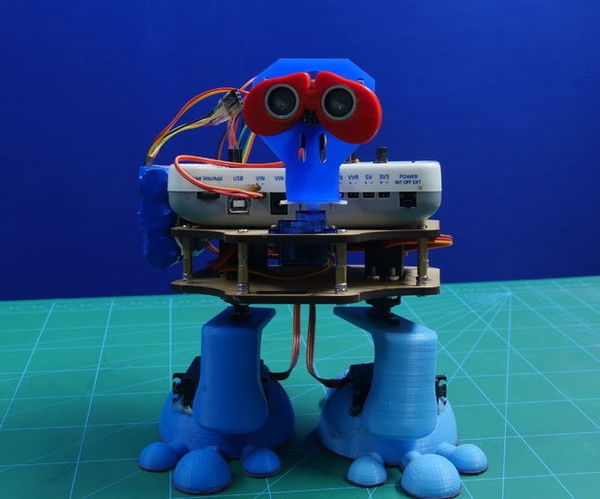
Autonomous Biped Robot Using Arduino Based Embedded Platform
"All the animated movie lovers out there! You sure remember WALL-E, dont you? And how adorable that robot is! Only if there was a way to have on. Guess what! There is a way, one with a twist." [...]

How to Make a USB Laptop Keyboard Controller
"This Instructable will provide a step by step procedure for building a USB laptop keyboard controller. I created this guide and video to hopefully make it easier for people to re-purpose an old laptop. A typical laptop keyboard relies on the motherboard for the scanning circuitry. I use a Teensy microcontroller mounted on a connector board to take over this function. Teensies are often used by the mechanical keyboard enthusiasts at Geekhack and Deskthority and the TMK software is the most popular controller code. The TMK code is a bit of an overkill if you just want a simple USB keyboard but it will certainly provide all the features you could ever need." [...]
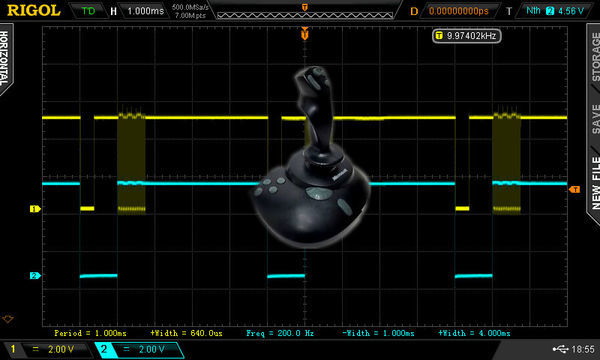
AVR Interface to Microsoft SideWinder Gamecontrollers
"Since the old days of gaming with a joystick (they have all vanished, do they?) I have an Microsoft Sidewinder Precision Pro lying around here. I plan on building a Quadrocopter soon and it seemed like the perfect device to control such a flying vehicle. Reading through Google and Wikipedia I stumbled across US Patent 5628686 which is titled as "Apparatus and Method for bidirectional Data Communication in a Game Port" and explains a Method used to communicate digitally through a traditional analog-style Gameport. The explanations in that Patent were the Basis of my Experiments with the Device I have. I found them to not 100% match the reality but backed with all that Information I was able to reverse engeneer the Protocol used to talk to the "Precision Pro"-Joystick, analyze and use the received data." [...]
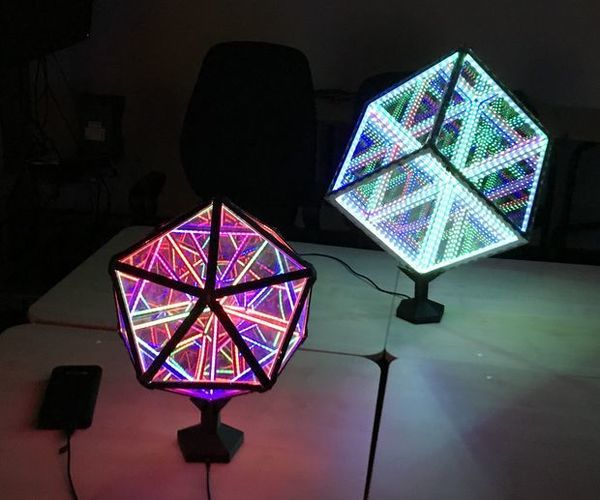
Infinity Icosahedron 2.0
"Since Make Munich come closer with giant step,s it is time to build some new exhibits. First test with a taped together ikosahedron where successful, so i wanted to build a more cleaned up version out of spy mirror acrylic for better reflections. On a side project while waiting for the 3D-prints i also built the simple cube version. A laser cutter is used for cutting both acrylic mirrors as well as diffusor plates for the icosahedron and the frame for the cube, while a 3D-printer is used for the frame of the icoshaedron and stands. WS2812b stripes with an ESP32 as controller are used for enlighting. The cube uses stripes with 60 LEDs/m, the ikosahedron stripes with 144 LEDs/m." [...]
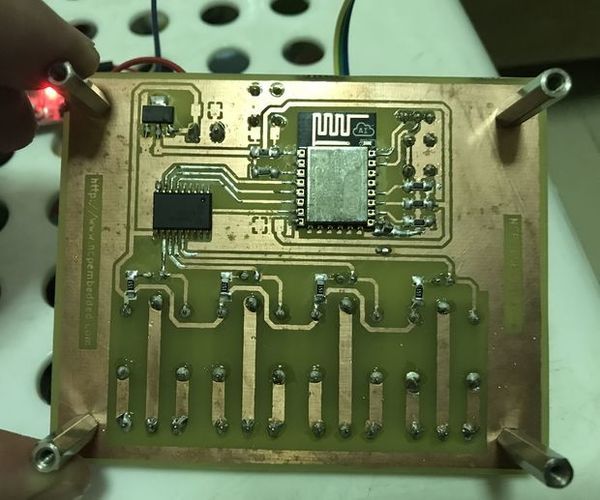
Home Automation - Control Relays From Everywhere Using ESP8266 + Blynk
"There are many ways to made a home automation, Some are complicated, Some are easy, This instructable I will show how to make a simple relays control using ESP-12E with Blynk. For convenient the design was single side PCB So you can make by your self at home or even send the gerber file to PCB manufacturer to make it for you. " [...]
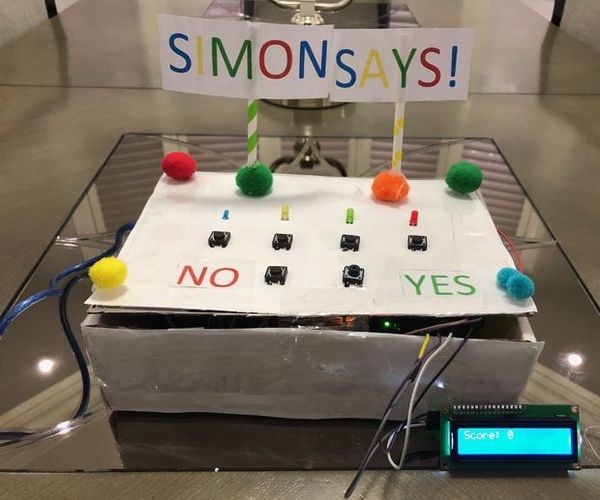
Simon Says With LCD Display
"Intro Have you always wanted to create an Arduino project that is one, really fun to play with, and two, easy to build. Well look no further. Hi there and welcome to my instructable. Here, I will be teaching you to create a Simon Says game with a LCD display. Idea As I was looking for a project to create for my final evaluation assignment for computer engineering, my teacher gave my class some ideas to create for a project. One of her ideas was to create Simon Says." [...]

Genesynth: A Sega Genesis-inspired synthesizer
"My largest side project over the last year has been the Genesynth - an open-source hardware synthesizer inspired by the Sega Genesis / Mega Drive. It started with a crazy idea and amazingly ended up with a functional, incredible sounding synthesizer. While I'm not totally done with the project, it's close enough for me to really share it with the world. This post introduces you to this synthesizer and how I built it. Feedback is always welcome, and I would especially love to know which technical details you'd like me to go into in future blog posts. The inspiration As noted in my first build log about the Genesynth, I grew up listening to Sega Genesis music and it left a permanent impression on me." [...]

Interactive Touchless Light
"Hi everyone! I'd like to share the project I have been working on here. I got inspired to experiment with capacitive touch sensing through a project in my university. I found out about this technology through instructables and used the things I learned here and from other places on the internet to build my own touch-less controller, which I use to blend different RGB values to create interesting light colors. For starters, when I started this project I knew next to nothing about either electronics nor capacitive touch sensing. Some problems I ran in to early on were caused by misunderstanding what actually happens." [...]
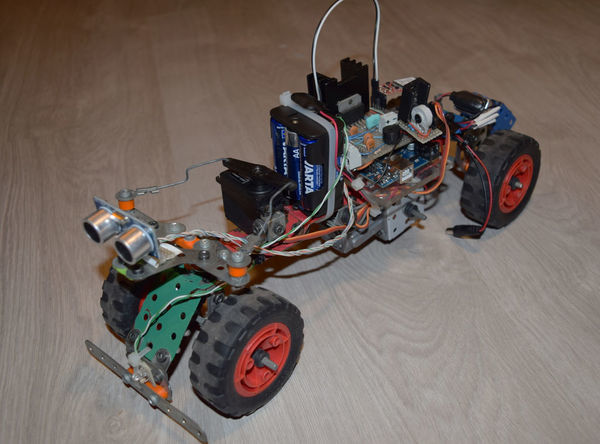
RoverBluetooth: Arduino-based Bluetooth Car
"RoverBluetooth is the name I gave to the Arduino-based Bluetoothcar I made for my school exam when I was only thirteen. I also showed it at Maker Faire Rome with a FabLab (and I was one of the youngest there)! Its very easy to make (only a few low-cost electronic components and a Meccano pack) and to control, thanks to the Android app I programmed. It features full speed control, reverse gear, an ultrasonic sensor with parking sound and emergency brake, low-latency remote drive and a frontal light. " [...]

Gesture Controlled Universal Remote With Node-MCU
"Hello everyone and welcome to this project! I am quite a lazy person and a lazy person's nightmare is to be watching TV when you realize that the remote is too far away! I realized that my remote will never be too far away if I have it on hand at all times. That inspired me to create LAZr, the gesture controlled universal remote. In this project, I will be creating a glove equipped with sensors that are able to detect hand gestures and can send signals to a TV or other appliance with a simple finger movement. " [...]
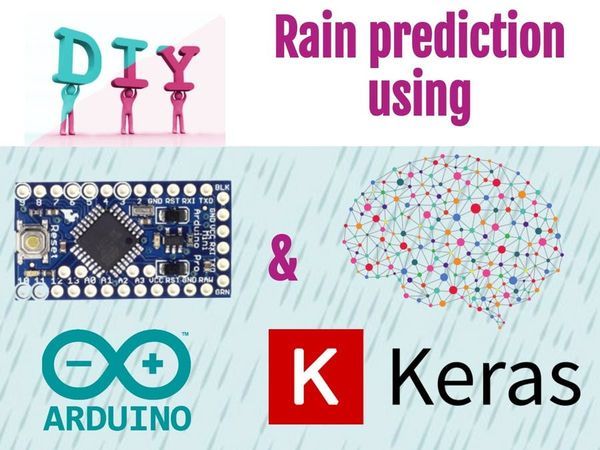
DIY Rain Prediction Using Arduino, Python and Keras
"So the big aim here is obviously to predict the rain in the future. We'll build a system that does just that from scratch! Story First a few words about this project the motivation, the technologies involved and the end product that we're going to build. So the big aim here is obviously to predict the rain in the future (we'll try 6 hours). The prediction will be a yes or no (boolean in programming terms). I've searched from tutorials on this matter and I haven't found one that is complete in every way." [...]
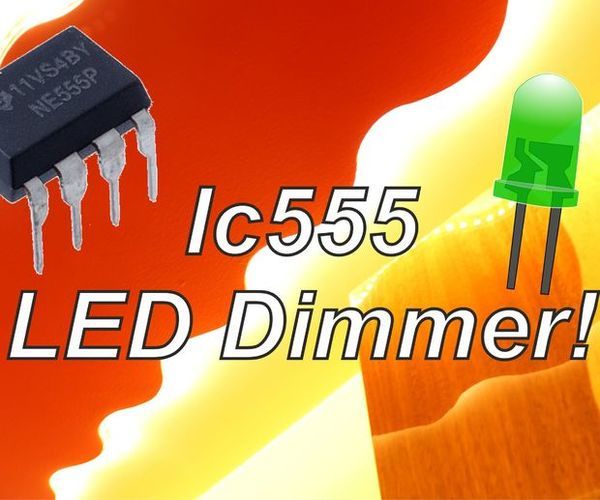
IC555 LED Dimmer! | DIY
"Hi guys!In this Instructable, I'll be showing you how to make LED strip dimmer using a few potentiometers and an IC555 timer. I'm currently working on a larger project which involves using this circuit, So I thought it would be good to share this circuit since it's really cool to play with just by itself. So let's get Started! " [...]

Circuit Learn NANO: One PCB. Easy to Learn. Infinite Posibilities.
"Starting out in the world of electronics and robotics can be quite daunting at first. There are many things to learn at the beginning (circuit design, soldering, programming, choosing the right electronic components, etc) and when things go wrong there are many variables to keep track of (wrong wiring connections, damaged electronic components, or error in the code) so it is really hard for beginners to debug. A lot of people ended up having a lot of books and buying many modules, then eventually lost interest after encountering multiple problems and getting stuck. Digital programming made simple with the Samytronix Circuit Learn - NANO! Starting 2019 I will label my projects Samytronix. The Samytronix Circuit Learn - NANO is a learning platform that is powered by an Arduino Nano." [...]
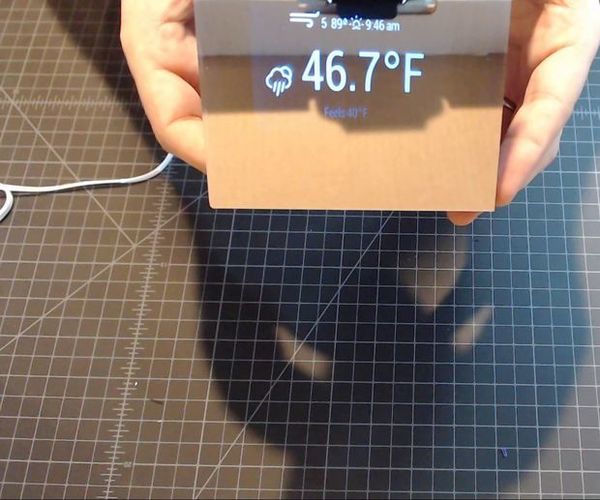
Mini Magic Mirror for Under $60 USD
" A 'Magic MIrror' is a project where a 2 way mirror is placed over a screen of some sort. Where the screen shows black pixels, the mirror is reflective. Where the screen shows white or lighter pixels, they shine through. This creates an effect of being able to have digital text, icons, or even images show through a mirror, while still maintaining the reflectivity. The third picture above should show what that can look like. The youtube video shows the assembly end to end, and has a demo at the end showing what the finished project looks like." [...]
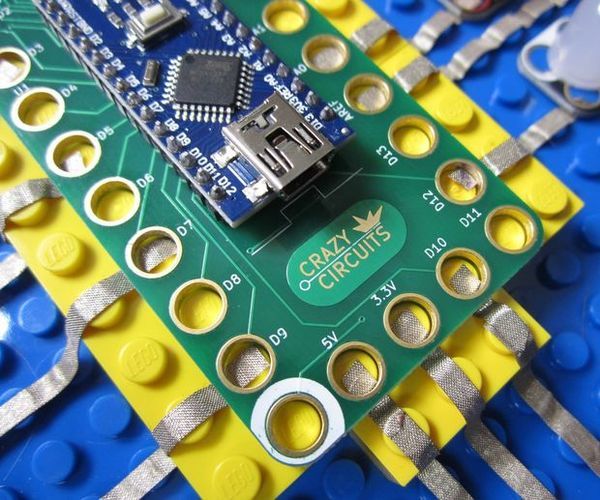
Crazy Circuits: an Open Source Electronics Learning System
"The education and home market is flooded with modular electronics 'learning' systems designed to teach kids and adults key STEM and STEAM concepts. Products such a LittleBits or Snapcircuits seem to dominate every holiday gift guide or parent blog for educational toys. However, these systems always come with a heft price tag attached and many feel more like toys than learning tools. About three years ago we started started designing Crazy Circuits as a low cost, reusable, modular, non-soldering, fun, system that could be used as an actual learning tool. We wanted something that parents and teachers could easily integrate with kits they already had or inexpensive off the shelf components. Something for both the Maker Community to enjoy as well as the average adult." [...]
Dual Axis Tracker V2.0
"Way back in the year 2015 we designed a Simple Dual Axis Tracker for use as a fun student or hobby project. It was small, noisy, a little complicated, and provoked a lot of really weird community comments. That being said, three and a half years later we're still getting emails and phone calls from people all over the world wanting to build their own. Due to the success of our original project post, youtube video, and the kits we were selling we received a wide range of feedback from a wide range of users. Most of it good, some of it annoying, and quite a few that were along the lines of "wiring this thing up is really darn complicated so please spend an hour on the phone with us to figure it out." With that in mind we spent several months redesigning the project from the ground up to make it a much more streamlined and easy activity." [...]
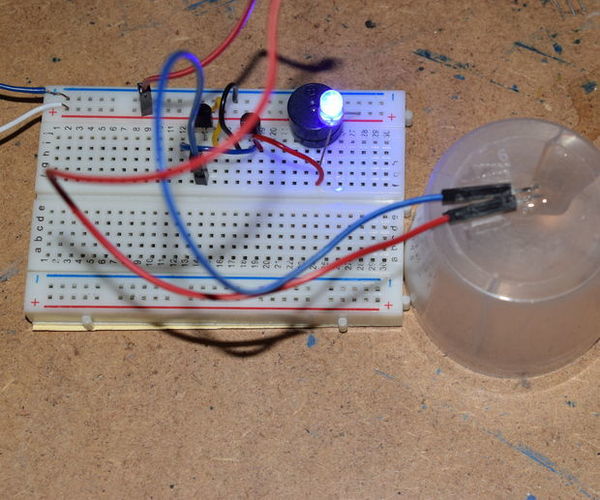
Water Sensor or Alarm Using 2N2222 Transistors
"Who doesnt hate it when it rains while some stuff are outside? (and you dont realise it is raining). At least I do! That is why I came up with this kind of project. Lets started! " [...]
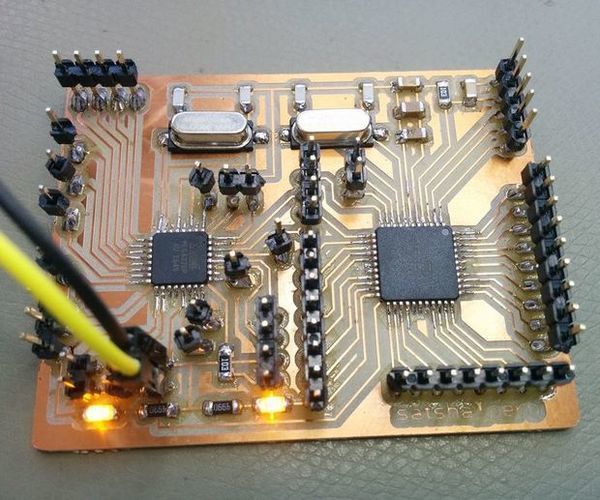
Satshakit Boards
"Hey makers and fabbers out there! Have you ever dreamed of making your own advanced micro-controller board at home and using smd components? That's the right instructable for you and for the brain of your next project :) And when I mean at home, I mean that you could purchase all the equipment to make all these PCBs for few hundred of dollars (see next steps) and put it in just one desk space! Everything started from my Fab Academy journey I did in 2015. With the objective of making a fabbed drone, I decided to release the prototype of the flight controller, as the first satshakit board. Just after one week the board got replicated by Jason Wang from Fab Lab Taipei." [...]

PCB Milling Using a 3D Printer
"I've made a number of projects and Instructables with electronic circuits. And most of them used a prototyping PCB. This works fine, and it's a quick way to finish a project. But creating a PCB yourself gives a project a more professional appearance. It looks less messy, and reduces the chance of faults and defects. That is why I started researching how to make PCBs." [...]

Custom Shaped PCB (Instructable Robot)
"I am an electronic enthusiastic. I made a lot of PCB. But most of them are the regular rectangular shaped. But I saw some custom designed PCB in most of the electronic equipment. So I try some custom designed PCBs in earlier days. So here I explain the making of a custom designed PCB." [...]
Bitcoin Tracker Using a Raspberry Pi
"Remember Bitcoin?.... the decentralized, new age currency, that was once traded at $19K which was supposed to revolutionize the global payment system. Well, it turns out that there are less than 3,585,825 Bitcoins left to mine. Around a year ago, I came across this post on r/bitcoin that talked about building a Bitcoin Clock across the street from the famous NYC Debt Clock. But instead of counting up like the debt clock, the Bitcoin Clock would count down how many bitcoin remains to be mined. This got me thinking." [...]

3D printed mower build
"Sit back, relax and let the robot do the work. At the same time the grass becomes thick and lush due to the constant mowing. No more grass cuttings - sounds to good to be true..... and by the way you built it yourself...... A great talking point with friends as the mower travels past doing it work 😊 Fully autonomous robot lawn mower. The mower project includes the mower itself a boundary wire control station and an optional charging station. The mower navigates within the boundary wire which is positioned (pinned) around the perimeter of the garden. Once the mower senses the perimeter wire, it stops reverses and moves off in a new direction." [...]
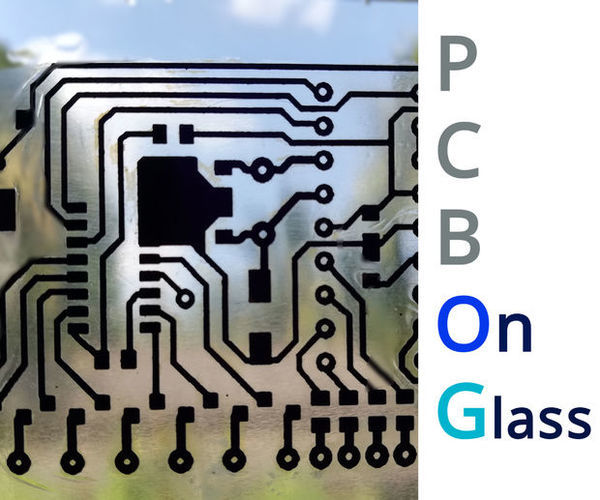
PCB on GLASS
"hello guys ! !, You may have or not the experience with printing your own custom PCB . There are so many methods to follow in order to make a PCB. The usual way to print a circuit is to apply the pattern(circuit) on a copper clad board and etch the unwanted copper.But if we can make the copper board our own, there are many possible creative things that can be performed. So in this instructable I'm gonna show you a method that could be used to make a custom PCB on anysuitable surface. Any surface want make this possible .In order to solder things on the surface that hold the copper layer sould sustain to higher temperatures around 270 degrees of celsius." [...]

A 2D Physics Engine
"A 2D physics engine with a lot of features made from scratch and running on an STM32F429. The project This project demonstrates that it is possible to run a 2D Physics engine made from scratch in Ada on a STM32, with some very cool results ! Basically, the project is split in two independent parts: The Physics engine, with its API, available for you to download and use for your own projects: https://github.com/Kidev/AdaPhysics2D It is of course open, and a tutorial to easily use it is available on the Github page of the engine. With it, you will be able to create awesome physics projects (like games) really quickly, efficiently (remember that it runs smoothly on a STM32), and without any actual knowledge in physics ! The STM32 wrapper, made with the help of Adacore's Ada_Drivers_Library, that provides an easy and fun way to discover all the features of the engine: https://github.com/Kidev/DemoAdaPhysics2D" [...]
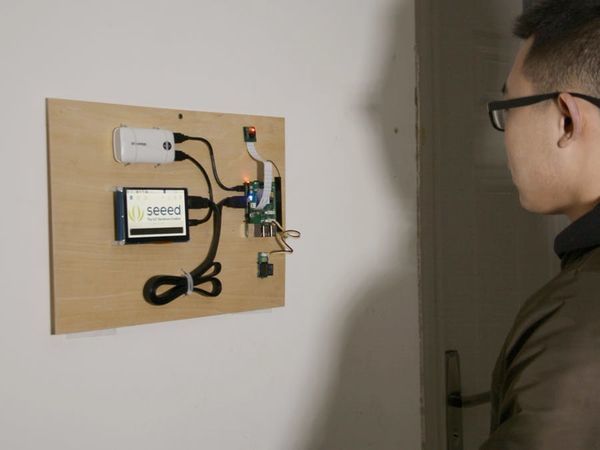
Face Recognization Smart Lock with LTE Pi HAT
"Face recognition is becoming more and more widely used, we can use it to make a smart lock. In this project, we plan to take pictures with picamera and recognise faces in them, then display recognition result in the screen. If faces known, open the door, and send who opened the door to specified phone number via SMS. So you need to connect a camera to Raspberry Pi's camera interface, and install antenna and Grove - Relay to LTE Pi hat, then plug HAT to your Pi. Screen can be connected to Raspberry Pi via a HDMI cable, don't forget connect power to your screen and Pi. " [...]
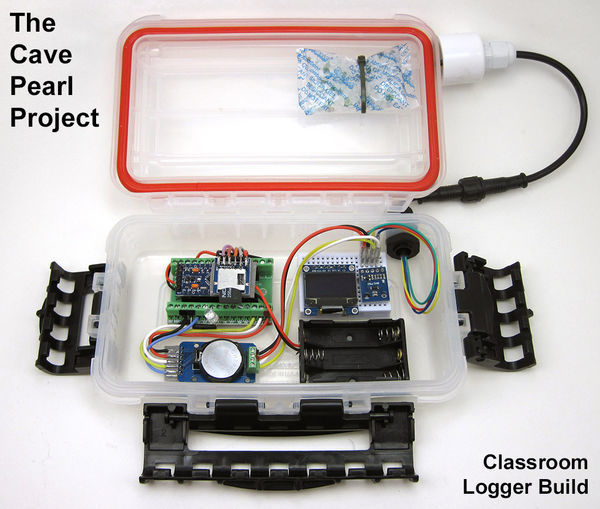
Pro Mini Logger Project for the Classroom
"“Instrumentation is a central facet of student, amateur and professional participation in science. STEM education, recruitment of scientists and experimental research are thus all hampered by lack of access to appropriate scientific hardware. Access restrictions occur because of: 1) lack of capital to purchase or maintain high-cost equipment, and/or 2) the nature of proprietary ‘black box’ instrumentation, which cannot be fully inspected, understood or customised… …In addition to reducing opportunities for people to engage with science, this lack of access to appropriate hardware restricts scientist’s creativity in experimental designs.” Last year’s intense deployment schedule focused on getting more sensors into the field, which left little time for development of new approaches to the logger itself. Now that everything is settling into the school term routine, it’s time to update the “classroom edition” of the Cave Pearl Logger with feedback from three years in the trenches:" [...]
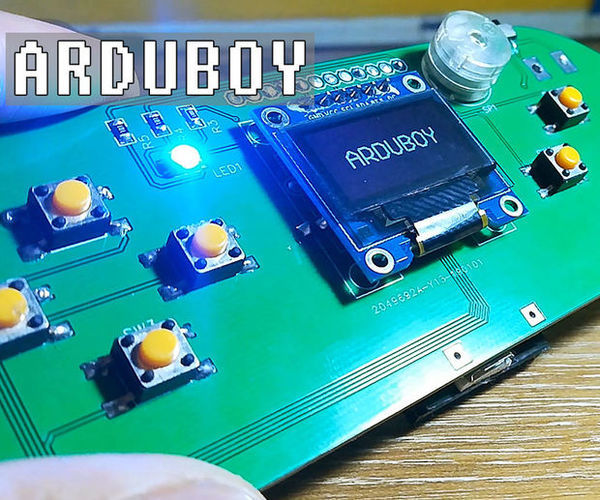
Arduboy Clone
"A few months ago I came across Arduboy which according to its official website is a miniature 8-bit game platform that makes it easy to learn, share and play games online. It is an open source platform. The games for the Arduboy are made by the users. Arduboy is based around ATmega32u4 which is the same microcontroller used in Arduino Pro Micro. Although I am not yet capable of making games, I decided to make build the hardware part of it on a breadboard. And yes, it worked!" [...]
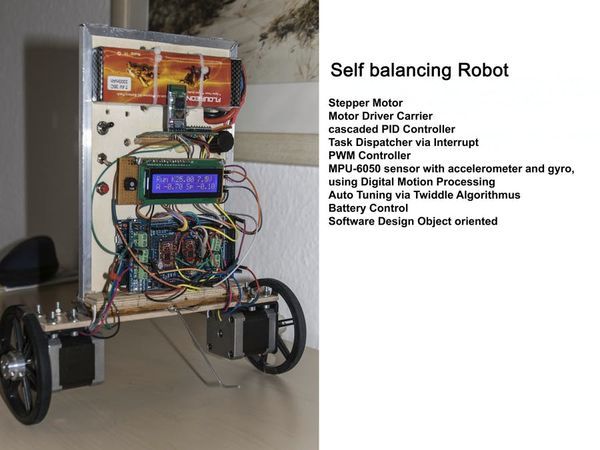
Self Balancing Robot via Stepper Motor
"With stepper motor via microstepping, digital motion processing, auto tuning via Twiddle Algorithmus, cascaded PID Controller I bought my first Arduino three years ago. I was fascinated by by the idea of a self-balancing-robot and this was my first project. I underestimated the difficulties, so the development took a long time. Many changes were necessary: The most important changes were: - Change from Arduino Mega to Arduino DUE - Change from direct-current-motor with encoder to stepper motor - Use of digital motion processing - MP 6500 stepper motor driver carrier Features of the Robot - Control of the robot via an Android Bluethoot App. - Stepper Motor, Unipolar/Bipolar, 200 Steps/Rev, 42×48mm, 4V, 1.2 A/Phase - Stepper Motor Driver Carrier can deliver up to 1.5 A per phase continuously, four different step resolutions: full-step, half-step, 1/4-step, and 1/8-step. - cascaded PID Controller for Motor and for Position - Task Dispatcher via Interrupt - PWM Controller - MPU-6050 sensor with accelerometer and gyro, using Digital Motion Processing with MPU-6050 - Auto Tuning via Twiddle Algorithmus - Battery Control - Software Design Object oriented - planned Step: drive in all diretcions Restrictions Running only at Arduino Due Stepper Motors I decided to use Stepper engines because they offer the following advantages: Exact positioning, no accumulated errors Holding torque in rest position No deceleration/lag due to the moment of inertia of the motor simple position sensing by counting PWM signal MPU-6050 Accelerometer + Gyro The MPU-6050 sensor contains a MEMS accelerometer and a MEMS gyro in a single chip." [...]
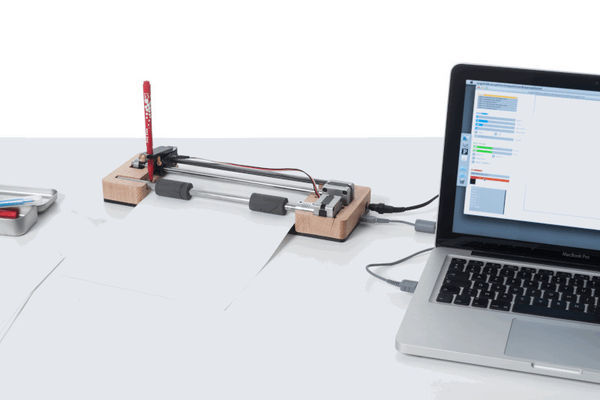
The Plotter Story
"It's funny how the most random event can lead you on some multi-years quest. My passion for plotters started with such an event. My friend Alexandre had a broken desktop printer and, knowing my passion for dismantling things, proposed to give it to me. I spent a great evening marvelling at the inner complexity of such a common appliance, not knowing that it was the beginning of my passion for CNC machines. CNC machines (for Computer Numerical Control) are tools that transform bits into atoms. I spend the following summer self-teaching practical electronics with my Friend Sebastian (who went on working at Festo), to be able, by myself, to build some." [...]
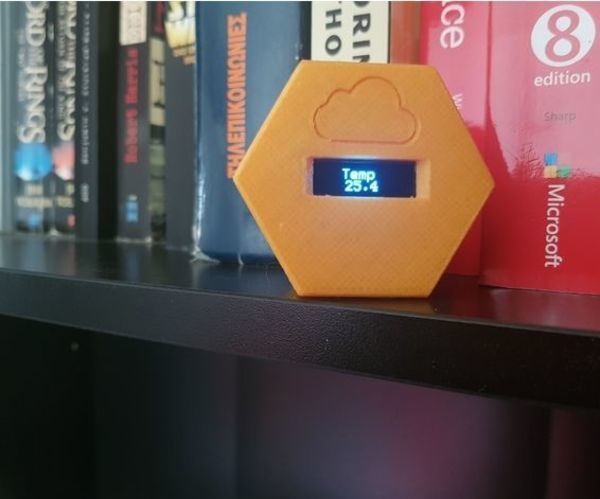
Digital Temperature Widget / Home Thermometer
"A small and good looking digital thermometer using the Dallas DS18B20 digital sensor and an Arduino Pro Micro at 3.3v. Everything is designed to fit exactly and to snap in place, no screws or glue needed! Not that much to it but it looks cool. Parts Used & Amazon links: - Sensor: DS18B20 - Display: 0.91" OLED Display - Microcontroller: Arduino Pro Micro - Battery: CR123 - Resistor : 4.7k Ohm Resistor" [...]
That's all Folks!


